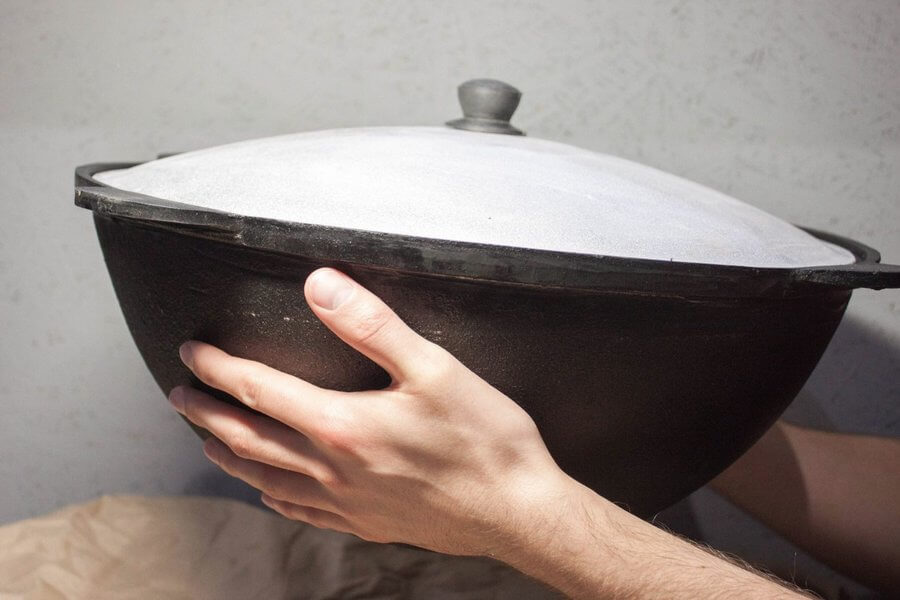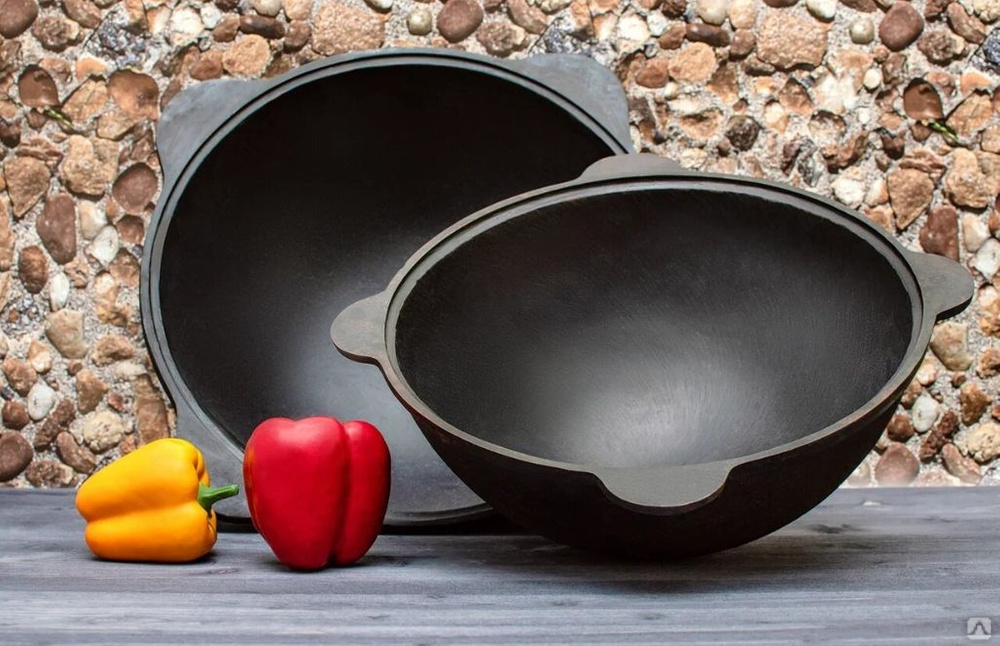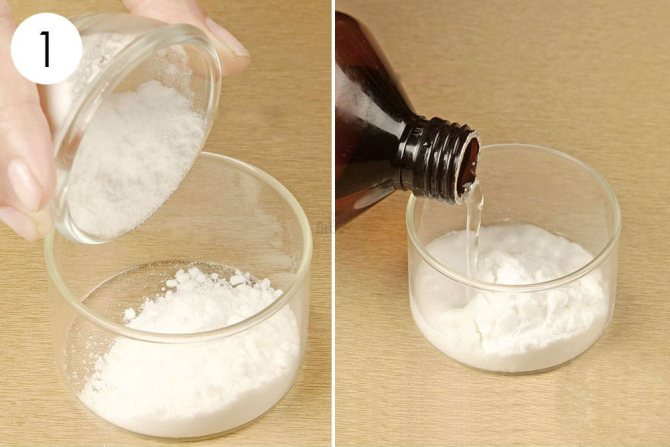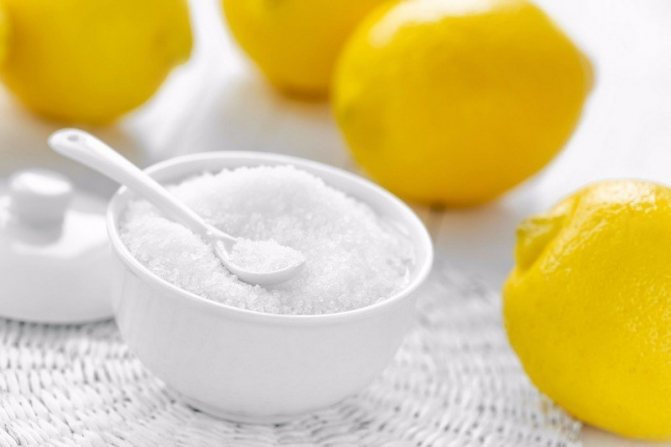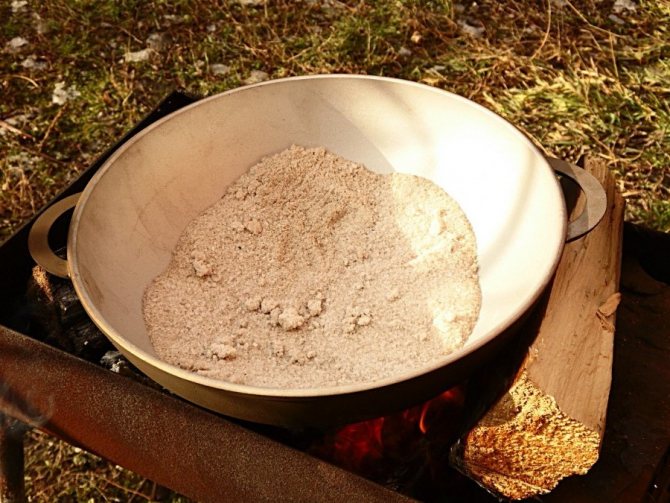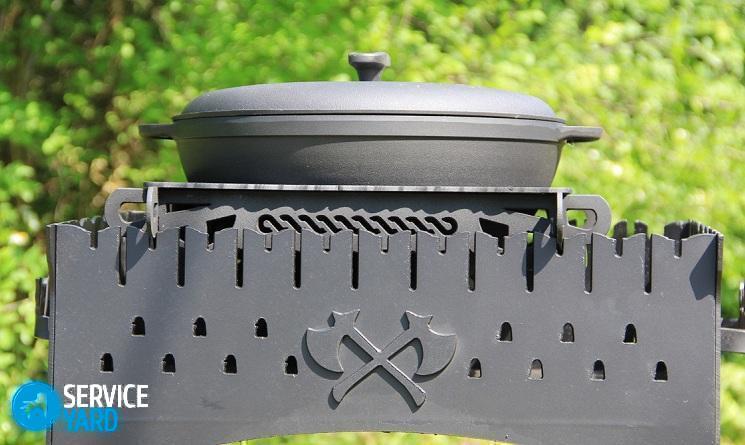What is a cauldron and what are the features of dishes
Culinary experts all over the world appreciate the traditional dishes of Asia for their special rounded shape. Everything is cooked in it:
- Sauces;
- Meat;
- Desserts;
- fish;
- Rich soups;
- Pilaf is considered a traditional dish.
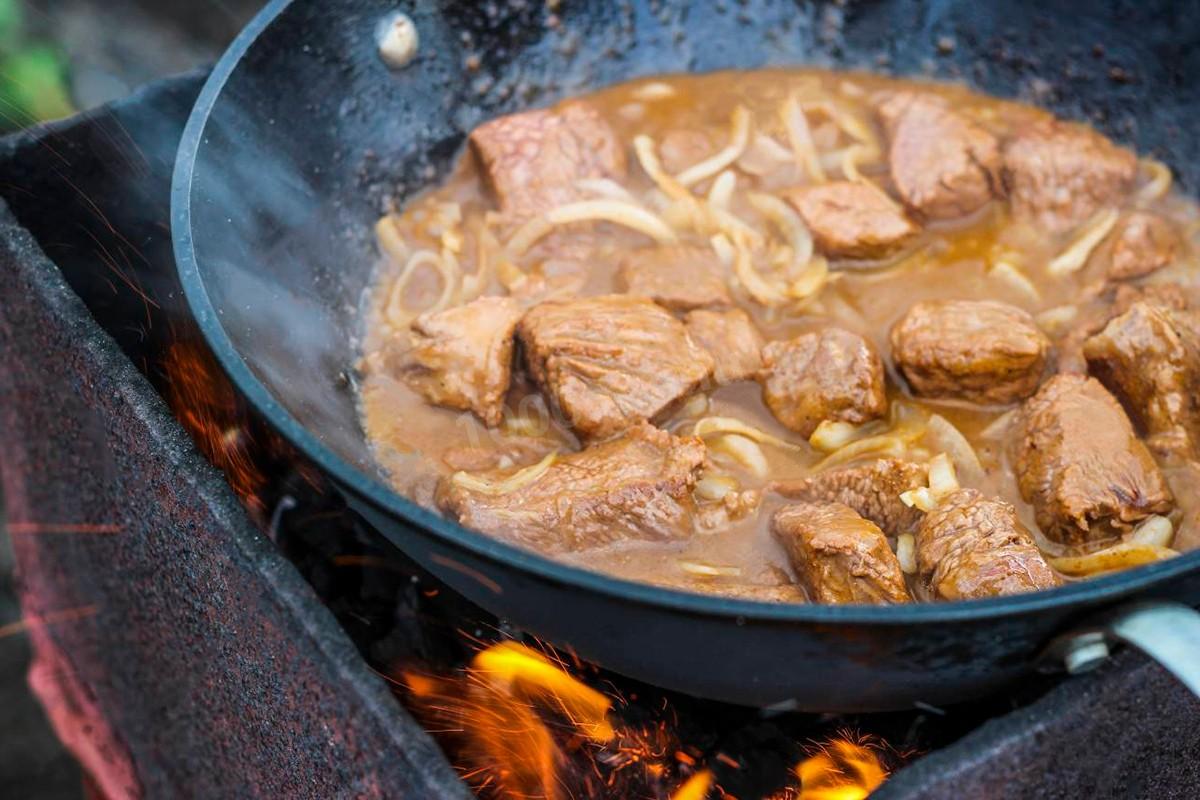 Kazan is the national dishware of the peoples of Central Asia.
Kazan is the national dishware of the peoples of Central Asia.
The cauldron is convenient for outings into nature. It is installed:
- On a portable tandoor;
- Tripod over the fire;
- Mangale of suitable size;
- hot coals.
Mix food well in a round bowl. It absorbs less oil - it flows down the walls to the bottom. It languishes for a long time due to thick walls, it comes, saturated with aroma. In such a container, food cooks evenly.
The history of the cauldron goes into the deep past, has many centuries. Since then, its form has hardly changed.
In the East, copper cauldrons were in use, now duralumin and cast iron have become traditional alloys. The physical properties of metals differ significantly. They are united by high porosity and heat capacity.
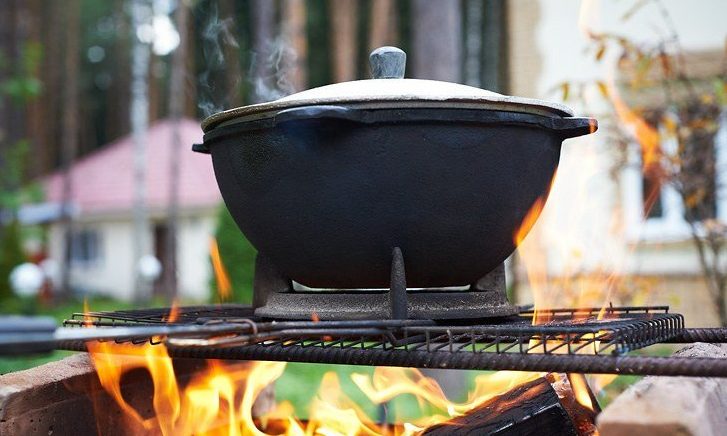 The cauldron is convenient for outings into nature.
The cauldron is convenient for outings into nature.
What is being prepared
The cauldron is considered to be a national Asian dish, which is used by housewives in many countries. This is a universal container that is used for cooking most dishes.Due to the ideal rounded shape, cauldrons are used to create the following dishes:
- boiled fish;
- rich soup or borscht;
- pilaf;
- meat dishes;
- sauces.
Sometimes people use cauldrons to create sweet desserts.
Differences in cleaning aluminum and cast iron cauldron
Although the rounded walls burn less often than the straight surface of the pan, the fat still sticks to the walls, sometimes food particles burn. How to clean a cauldron made of duralumin or cast iron? For this, different methods are used.
Aluminum is not very capricious:
- It can be put in a washing machine, the functionality of the dish will not change;
- Cleaning with hard abrasives, metal washcloths is allowed;
- It is acceptable to wash with detergents that do not contain oxalic acid, from which the alloy tarnishes, the upper oxide layer becomes loose.
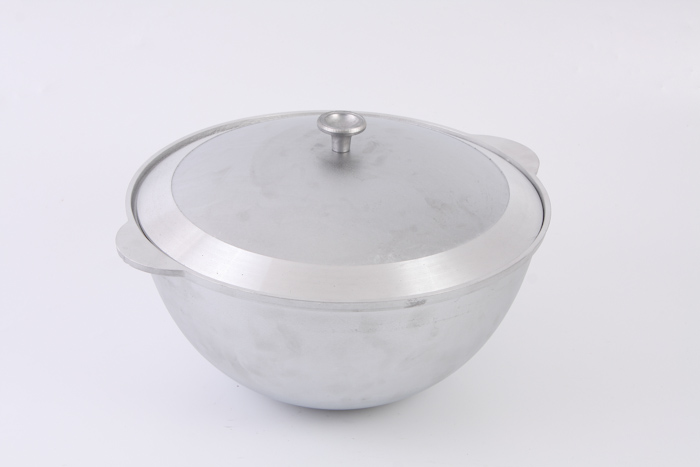
An aluminum cauldron can be placed in a washing machine, the functionality of the dish will not change from this.
Cast iron cauldron requires careful treatment:
- It can shatter from falling;
- Requires bluing - oil firing, anti-corrosion protection and a non-stick layer are created (it has to be restored from time to time);
- Cast iron does not like scratching, this destroys the oily layer, opens micropores, food particles clog in them;
- Machine washing is unacceptable, cast iron will immediately begin to rust.
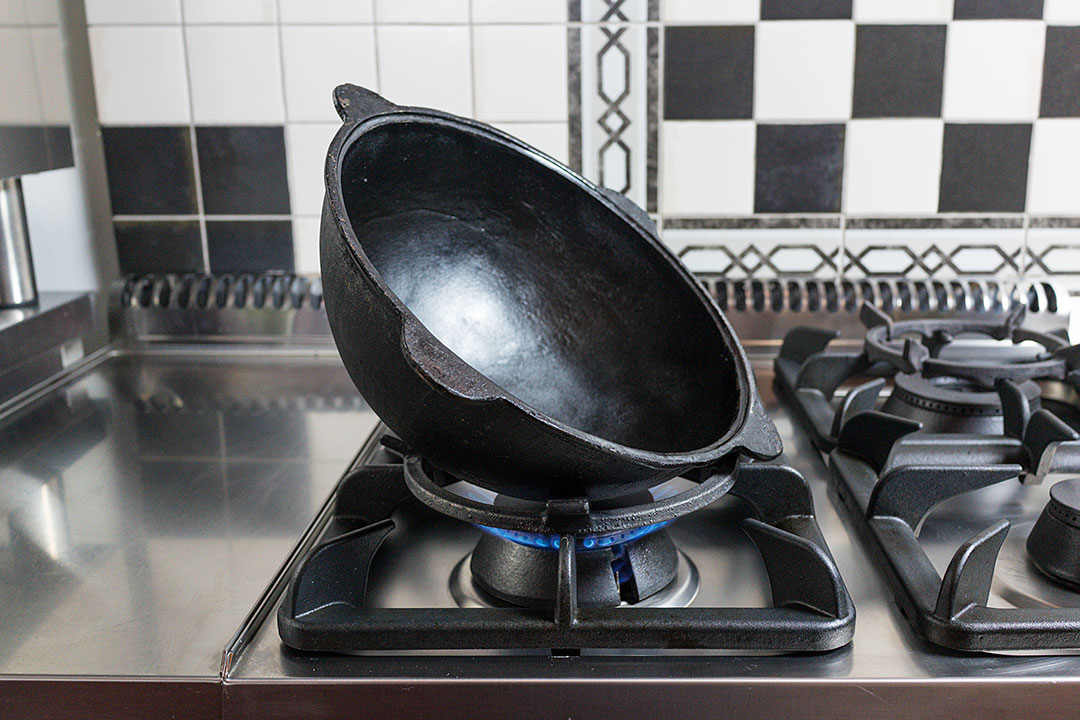 A cast-iron cauldron can break from falling.
A cast-iron cauldron can break from falling.
How to wash a new cauldron before use

Cast iron cauldrons are made in a special way of pressing. As a result, technical oils and dirt get into the pores of the metal. To remove them before first use, clean the container with dish detergent and then roast it on a fire or stovetop.After the procedure, treat the surface with oil to create a natural non-stick layer.
Calcining a new cast iron cauldron
Cast iron is a material that is made by pressing or casting an iron alloy. The composition contains a small percentage of carbon, which over time leads to the formation of corrosion. To prevent this from happening, in production, the dishes are treated with technical oil. Before the first use, it is necessary to remove the industrial grease by calcination.It is performed once after the purchase of dishes.
You can remove the oil coating with salt. If the event is carried out in an apartment, it is recommended to ventilate the room, as sufficient smoke will be generated. Salt is poured into the cauldron, the stove is turned on. Salt is stirred occasionally, wait until it becomes brown. Then it is removed, the walls of the container are wiped with paper. Proceed to the second stage of processing.
A cast-iron cauldron is lubricated with sunflower oil so that the walls inside are saturated, a film forms. It protects against burning and sticking of food. Sunflower oil is poured into a cauldron and the dishes are heated. Fat of animal origin is suitable for lubricating the walls. It is optimal to use linseed oil, it quickly clogs the pores of the metal, forming a thin film on the surface. Warm up the container with oil for half an hour. Next, turn off the stove, cool the cauldron, wipe the walls with a clean rag. After the dishes are ready for cooking.
How to wash a cauldron after cooking
Cast iron cookware should be cleaned in a special way. Please note that cooked food cannot be stored in a cauldron. After cooking, transfer the dish to another pan.
If the food is not burnt, simply rinse the container with running water without detergents and wipe dry with a paper towel.
If the soot still remains, fill the cauldron with water by 1/3, close the lid, put on the stove and bring to a boil. After the procedure, all burnt particles can be easily removed.
If you clean the pot with detergent, the natural non-stick layer will wash off and you will have to re-create it. Use this cleaning method only in extreme cases.
How to wash a cast iron pot
The peculiarity is in the structure of this metal. It is porous and easily absorbs foreign substances that are inside the pot. It can be food or chemicals that a preventive wash produces. That is why the usual fairy or other products are not recommended.
At the same time, the cauldron requires regular cleaning so that the products do not burn, forming soot. In this case, the properties of the pot will be violated.
Many do not know that cast iron requires a careful attitude. The use of abrasive products and hard brushes, as well as exposure to water, can greatly harm high-quality dishes. Despite its brutality and strength, the bowler needs careful care.
The cleaning scheme after cooking is simple:
- pour water and boil, leave to cool;
- drain the water and wipe with a rag or soft sponge;
- wipe dry with paper towels;
- oil a clean cloth and wipe the inside of the cast iron.
Be sure to use the oil after washing. It will help protect the pot from rust.
Pilaf or shurpa cooked in a cast-iron cauldron in nature? is a unique taste and atmosphere.But after such cooking, the cast iron will have to be thoroughly cleaned, and in natural conditions it is doubly difficult to do this.
A popular option is the use of sand. You can fall asleep at night and put on a slow fire. In the morning, all the soot will go away. The walls are also cleaned with an abrasive method, rubbing lightly. An alternative is to use coarse salt or a hard metal brush.
Cast iron is very susceptible to corrosion, red spots form even on new dishes. The ingress of moisture is detrimental to the material. But rust does not mean damage to kitchen utensils: they are easy to clean.
Coarse salt is poured into the cauldron and heated until the hands can still endure the temperature. Then mechanically begin to scrub each stain. After use, the salt is not suitable for use - it is thrown away.
A simple but expensive cleaning method is sandblasting with a special installation.
How to wash a cast-iron cauldron covered with soot and soot
Both homemade and the products offered by the chemical industry will help get rid of soot and soot. Of course, home remedies are safer.It is worth remembering to thoroughly rinse the cast-iron cauldron treated with any cleaning agents after cooking.
Soda, salt and vinegar
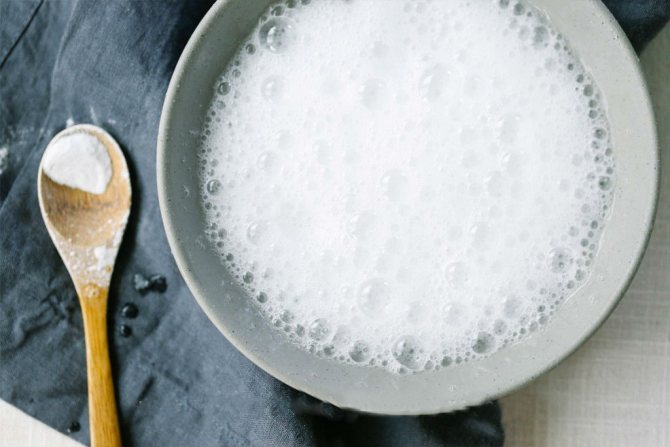
It is worth remembering that a small oil soot is simply necessary for a cast-iron cauldron. Without it, cooking in such dishes is impossible. It should be uniform, not have thickened dark areas of burnt fat. It is not worth washing such soot after cooking - just wipe the dishes with a dry cotton rag or napkin.
The porous structure of cast iron is conducive to the growth of "bad" soot, which gives the food a burnt taste. It must be thoroughly washed after each cooking.
How to clean:
- put a cast-iron cauldron on the fire and pour water to cover the contaminated areas;
- pour a glass of table (9%) vinegar;
- add 8-10 tablespoons of table salt;
- bring the mixture to a boil (boil for several minutes);
- put out the fire, add 5 tablespoons of soda.
Drain the water, wash the cast-iron cauldron with a sponge, brush or rag. Try not to scratch the inner walls.
Digestion (soap and glue)
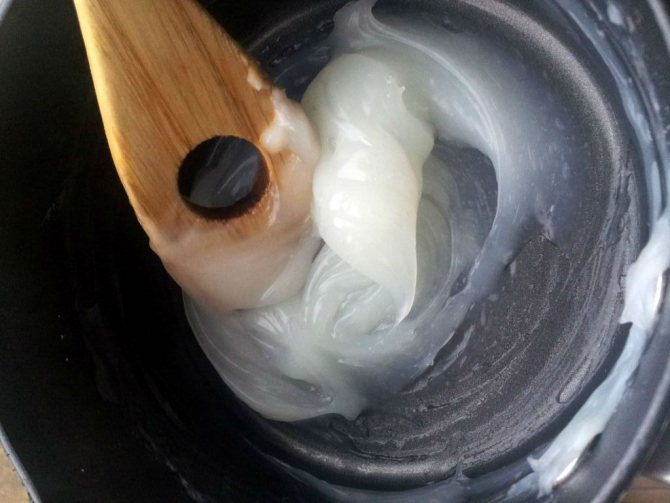
The most famous and effective method that helps to effectively wash a cast-iron cauldron after cooking is boiling. It is simple and complex at the same time. Experienced housewives note the versatility of this method, which will allow you to rid the cast-iron cauldron of soot, rust, and adhering fat.
To wash a cast-iron cauldron by boiling, prepare:
- a piece of laundry soap;
- 100 gr of stationery glue.
It is better to turn the soap into shavings so that it is easier to dissolve in warm water. Add soap and glue to the water. You will need to prepare a voluminous vessel in which you can place a cast-iron cauldron for boiling. The boiling time of the cauldron is 4 hours. After the cast-iron cauldron has cooled, it will be very easy to wash it. It is enough to hold with a rag or a soft brush - all the dirt and soot after cooking will disappear by themselves.
Be aware that adhesive fumes can be toxic.Good ventilation should be provided in the room where cleaning is carried out.
Hydrogen peroxide
Peroxide is an excellent tool from the first aid kit that will help wash off carbon deposits from a cast-iron cauldron after cooking. You will need to prepare:
- 150 gr of soda;
- 3 tablespoons of peroxide;
- a few drops of foamy dish detergent.
Mix all the ingredients, treat the dirty areas with the mixture and leave for three hours.After the time has elapsed, wash the cast-iron cauldron with a rag or sponge with an abrasive coating.
Lemon acid
The principle of action of citric acid is akin to that with which it is recommended to periodically wash kettles to rid them of scale. It is enough to pour water into a cast-iron cauldron to cover the dirt, add 5 tablespoons of citric acid. Boil the composition for several minutes. Leave for an hour.
It is easy to wash the remaining dirt - just walk over the soot with a sponge and rinse the walls with running water. You can use this method after each cooking.
Sand
Sand is a natural abrasive, which is convenient to use if you have to wash the cauldron after cooking in nature. Do not extinguish the fire on which food was cooked. Fill the cauldron with sand and leave it to slowly heat up in a bowl. It will take several hours to ignite the sand - at least 5. The sand is allowed to cool, then thrown away. Dirt is wiped off with a cloth.
Vinegar
Table vinegar can be used to pre-soak the cauldron. Prepare a solution of water and acetic acid (in equal parts). Soak the cast iron pot for 3 hours. If necessary, soak the dishes completely, and not just the interior. Soaking will soften the carbon deposits formed after cooking, a layer of fat and soot.
You will need to prepare an abrasive paste, which is recommended to wash the cast-iron cauldron after each cooking - table salt and vegetable oil. The paste should not be thick or runny. It is used to treat contaminants. After washing, the boiler is washed with running water.
Ignition with salt
This method is used both for preparing the cauldron for the first use, and for washing after cooking.Do not feel sorry for spices - a cauldron with a volume of 6-10 liters will need about 2 kg of salt. It is necessary to pour it into a cold cauldron. Then put the dishes on the fire and heat it, stirring the salt with a wooden spatula or slotted spoon. Stir in such a way that salt gets on all contaminated places. The darkening of the spice indicates that all the dirt has been absorbed into the crystals and the procedure can be completed.
Salt cannot be reused!
Household chemicals
Household chemicals can be very effective for cleaning cast iron pots after cooking. It quickly and gently removes the most persistent stains of soot and grease. It is recommended to carefully study the composition of such funds - many of them contain carcinogens. Toxic substances can destroy the protective layer, get into the porous cast iron surface. With further cooking, they can get into food and adversely affect health. If you constantly wash the utensils with aggressive chemicals, they can accumulate in the pores. Thorough rinsing is required after each wash.
Activated carbon
Activated charcoal is an effective sorbent that can wash the cauldron from fat and burning. It is necessary to take two or three plates (30 tablets) of coal and crush them. Moisten the walls of the cauldron and rub in the coal dust. Leave for 3 hours, then pour hot water and leave for another three hours.
Daily care of the cauldron
How to care for a cast iron cauldron? The non-stick properties of cast iron have been known since ancient times.
Important! Every time you cook, the oil penetrates the pores and creates a film on the surface that prevents rust and adds flavor to the food. If this film is peeled off, then the food will begin to burn.Therefore, you can not clean such dishes with metal washcloths, brushes and abrasive dishwashing detergents.
If your cast iron burnt food:
- Pour some water into it, put 2 tablespoons of salt and soda into it and put on fire.
- Boil this solution for 20-30 minutes over medium heat, and then make up and let the dishes cool.
- Then you can easily wash the dishes with a soft sponge.
Important! The cauldron cannot be washed in a dishwasher.
How to get rid of soot?
What to do if there is carbon deposits on the bottom and walls on the dishes. To deal with this problem, you will need a large basin in which you can boil the cauldron, as well as prepare the following mixture:
- water;
- a bottle of silicate glue;
- grated laundry soap.
Dissolve both components in hot water and put your cauldron in the solution. Put on a small fire and boil for an hour. Then clean it with a sponge and dry it.
Cleaning the cauldron from soot with household chemicals
In order to clean the cast iron cauldron, you can use a lye-based oven cleaner. The label must indicate that the composition includes sodium hydroxide.
Application:
- Apply the paste, rub it a little with a sponge into the surface and leave for 10 minutes.
- After the specified time, wipe off all deposits from the dishes, wash thoroughly with soapy water, and then rinse with clean water.
- In order to neutralize all the chemicals, rinse the surface of the cauldron with table vinegar.
- Wipe dry and carry out the calcination procedure with oil.
How to get rid of odors?
Cast iron has one drawback - it absorbs various odors well.If you have cooked any dish with a specific smell, then it may remain during subsequent cooking.
You can easily get rid of the smell by doing the following:
- Put the pot on a big fire.
- Pour about a kilogram of salt into it and calcine it for 30-40 minutes.
- Stir the salt regularly and distribute it along the sides of the dish. Salt absorbs odors and removes soot.
- Let the cast iron cool, pour salt out of it and wipe the inside with a napkin.
- Then grease the dishes with vegetable oil and reheat.
How to properly care for a cauldron
Cast iron alloys do not withstand aggressive cleaning for the following reasons:
- The non-stick layer is erased;
- The porous structure of cast iron is clogged with detergent residues and is difficult to wash.
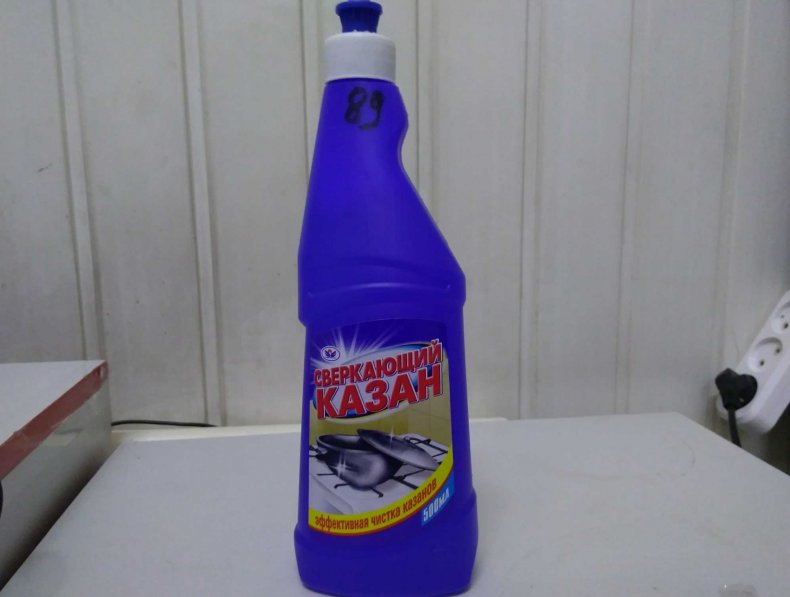
If fatty food is removed from the cauldron immediately after cooking, then it is enough to rinse the vessel with warm water and wipe it dry. If this method of cleaning did not work, how to clean a burnt cauldron? Pour water to a third of the depth of the vessel and boil under the lid. Then the water is drained, and the walls are wiped dry with a soft sponge.
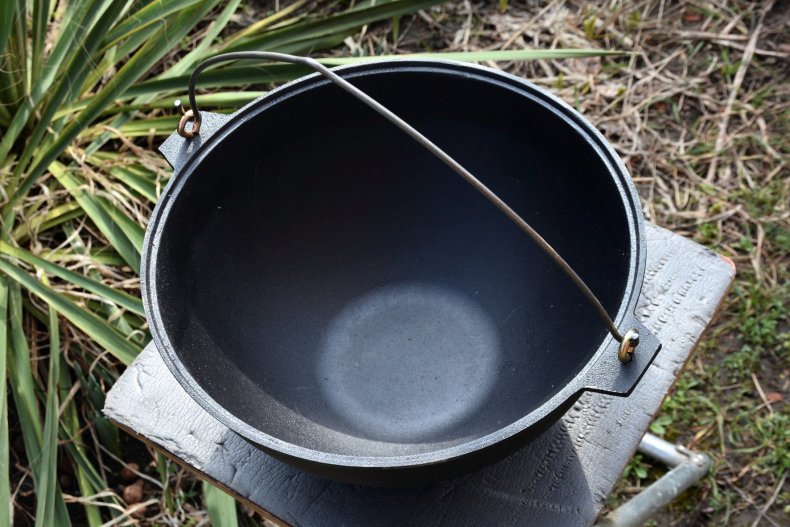
Note! If properly cared for, cast iron products will last for many years.
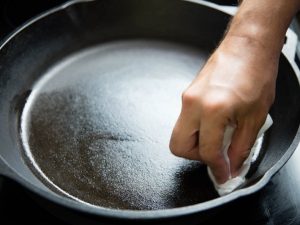
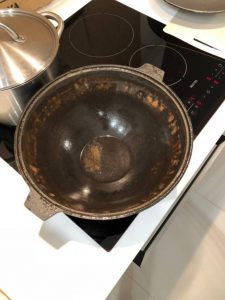
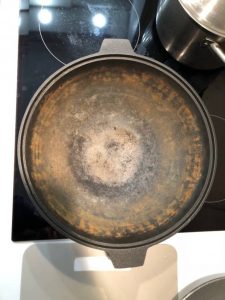
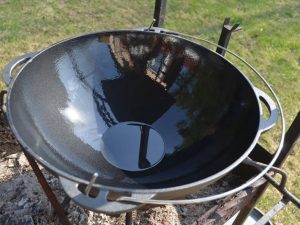
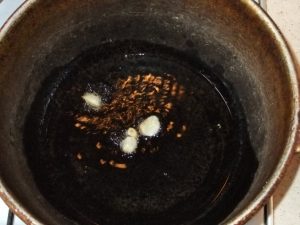
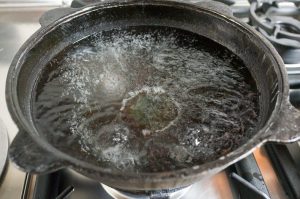
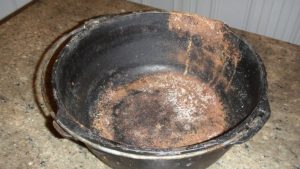
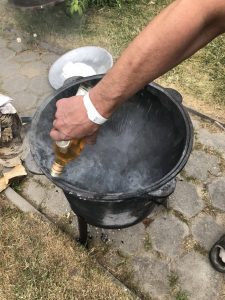 Store cast iron cookware in a dry place in an oiled cloth. The cauldron should be protected from high humidity so that rust does not form. After that, the dishes will be unsuitable for cooking.
Store cast iron cookware in a dry place in an oiled cloth. The cauldron should be protected from high humidity so that rust does not form. After that, the dishes will be unsuitable for cooking.
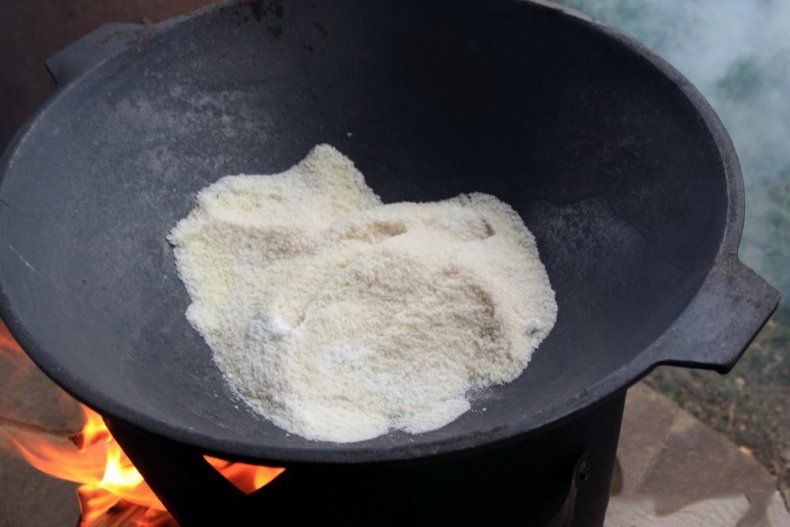
Top 5 household chemicals
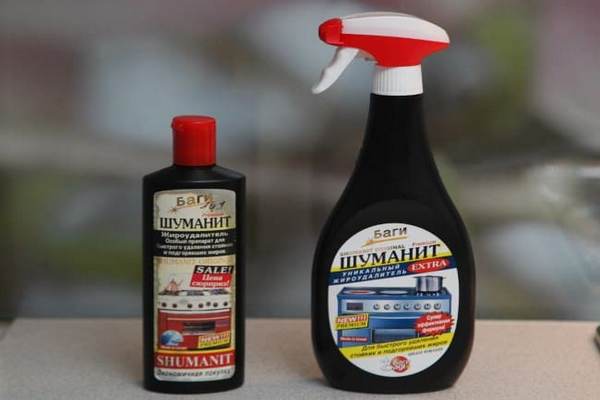 Not only with the help of folk recipes you can put the cauldron in order. Consider the most popular household chemicals among hostesses:
Not only with the help of folk recipes you can put the cauldron in order. Consider the most popular household chemicals among hostesses:
- Grease remover "Shumanit". Quickly removes not only fat, but also hardened pieces of food, burnt sugar, soot and soot.After application, the active ingredients break down dirt molecules in just a few minutes, turning them into an easily removable liquid.
- Grease remover "Unicum". Designed for quick and effective cleaning of stoves, grills, pots, cauldrons and frying pans. The unique formula quickly copes with soot and soot. With regular use, a protective surface is formed on the dishes, which prevents the following contamination.
- Miracle paste "Dr. Beckham". This household chemical is one of the most environmentally friendly. It is intended for removal of any pollution from any surfaces. Active components clean and polish, form a water-repellent film.
- Chrome Spray. This versatile cleaning spray is ideal for removing any kind of dirt on any surface. The composition is based on citric acid.From the first application, a protective antibacterial film is formed.
- Means for removal of fat, a scum and any other types of pollution "Unicum Grizzly". It is applied to the surface in the form of a spray. After contact with the dishes, foam immediately forms. while the reaction is going on, you should not touch the cauldron. As soon as the surface "calms down! should be rinsed thoroughly under warm water.
There is nothing complicated in cleaning the cauldron. Especially if you know what tools to use.
Photo-instruction for cleaning the cauldron
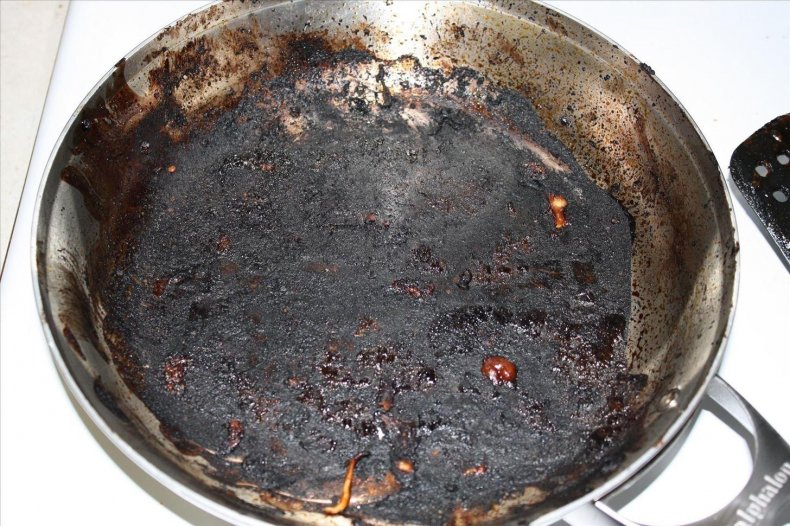
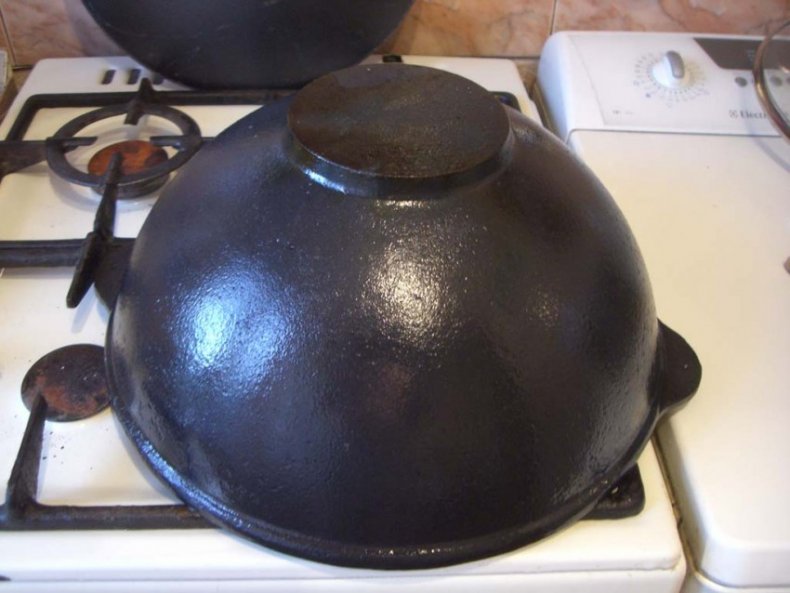
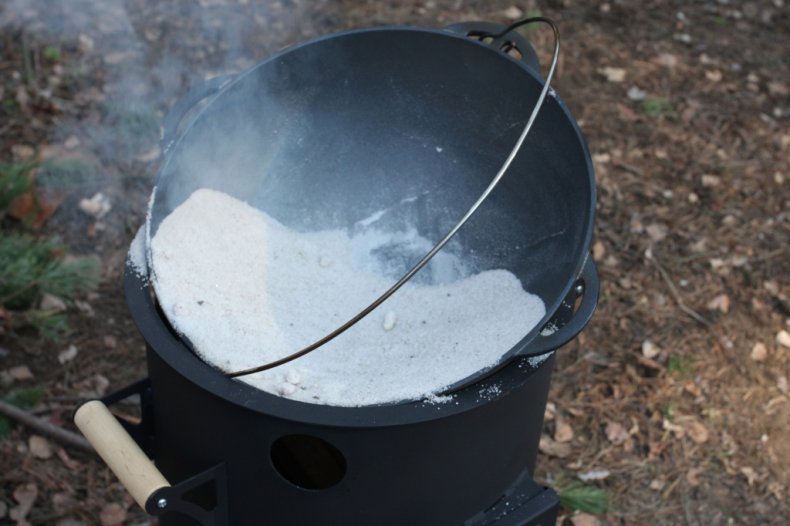

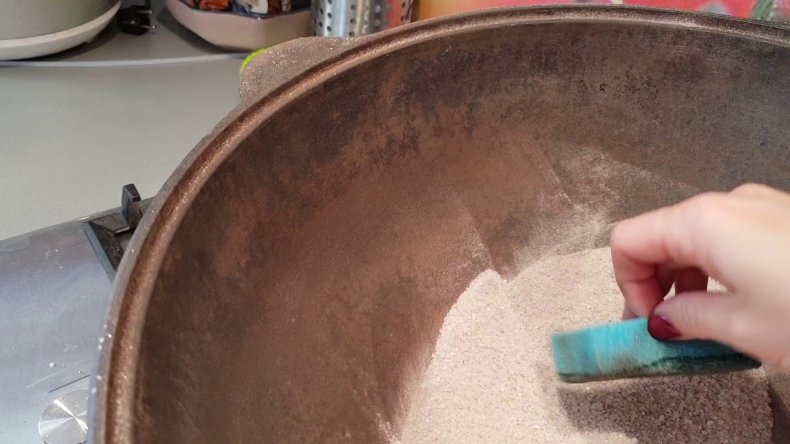
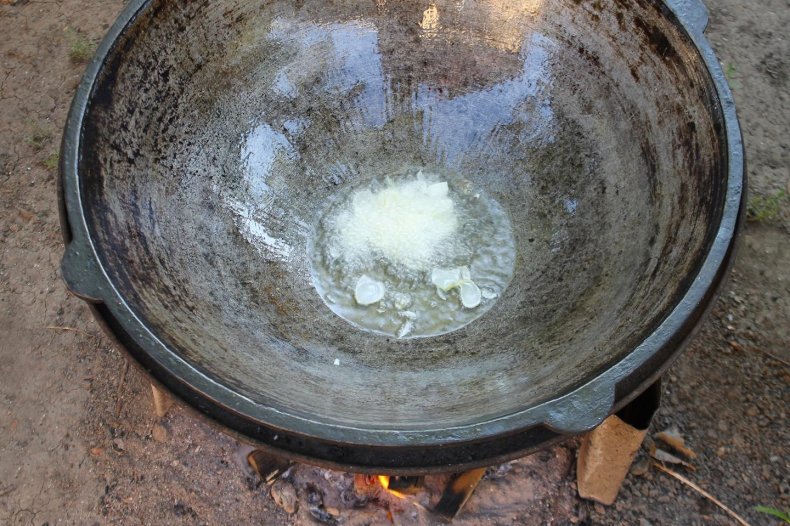
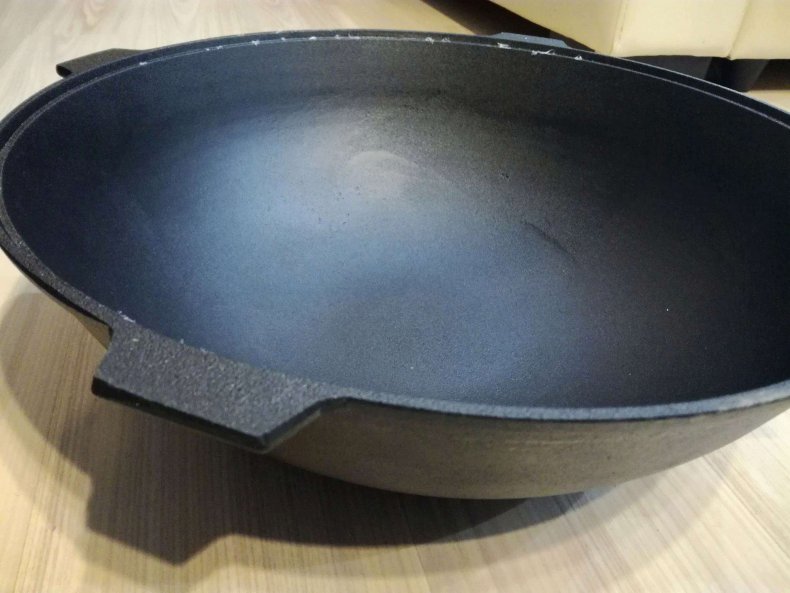
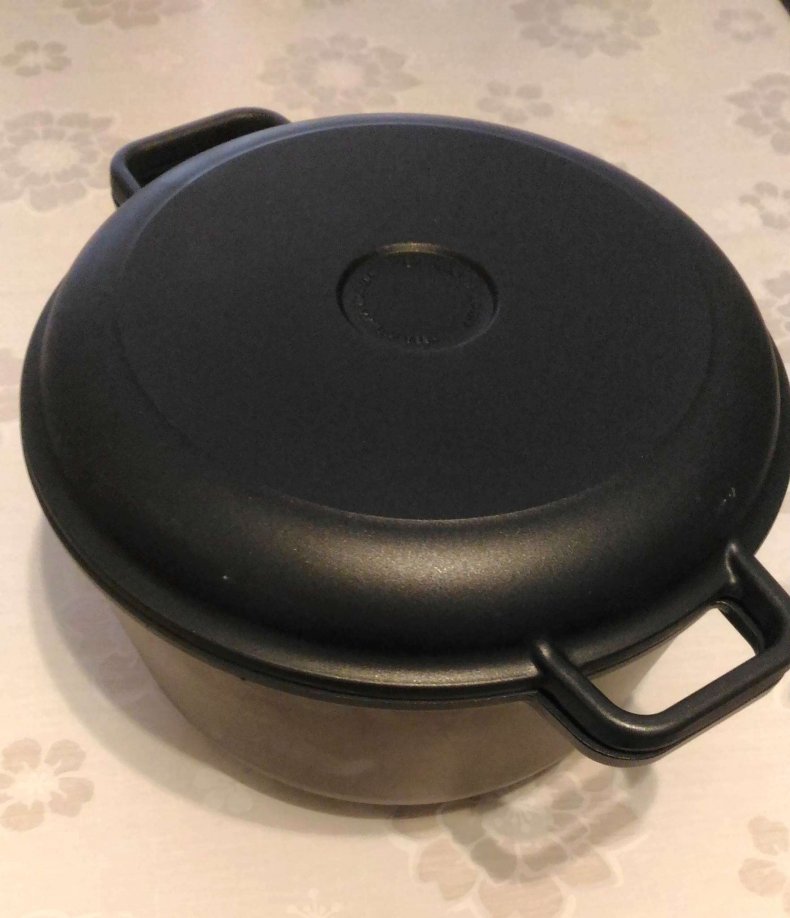

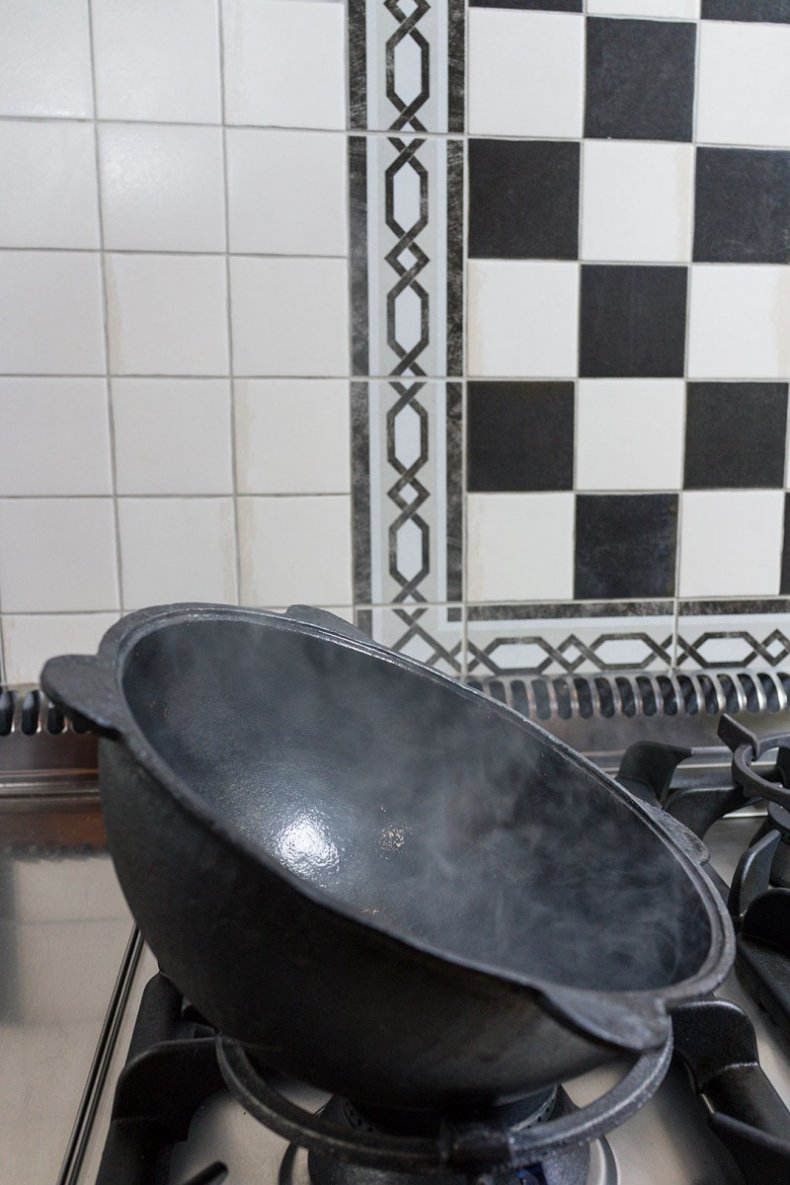
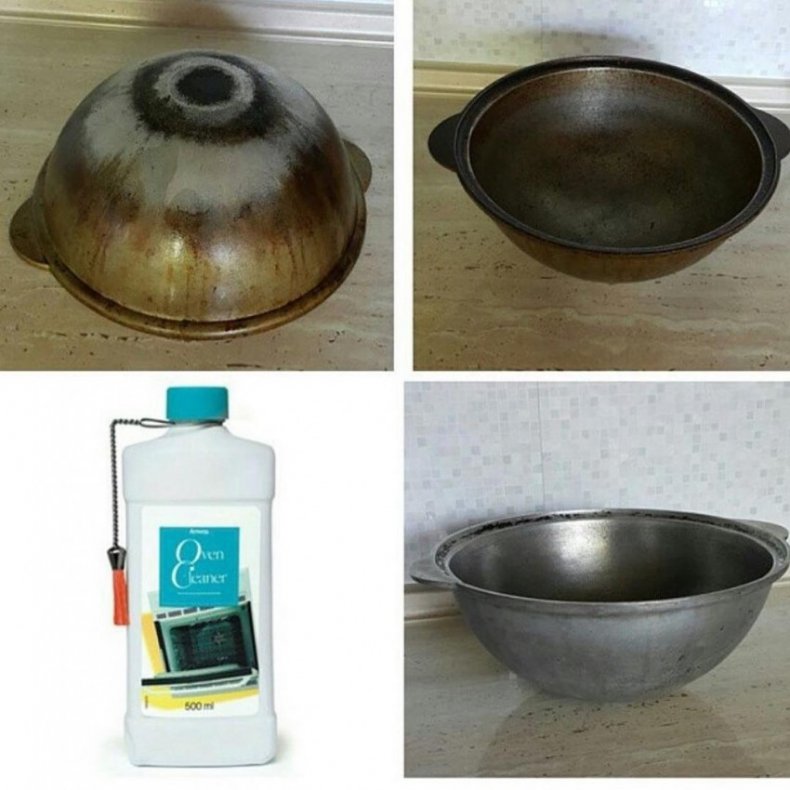
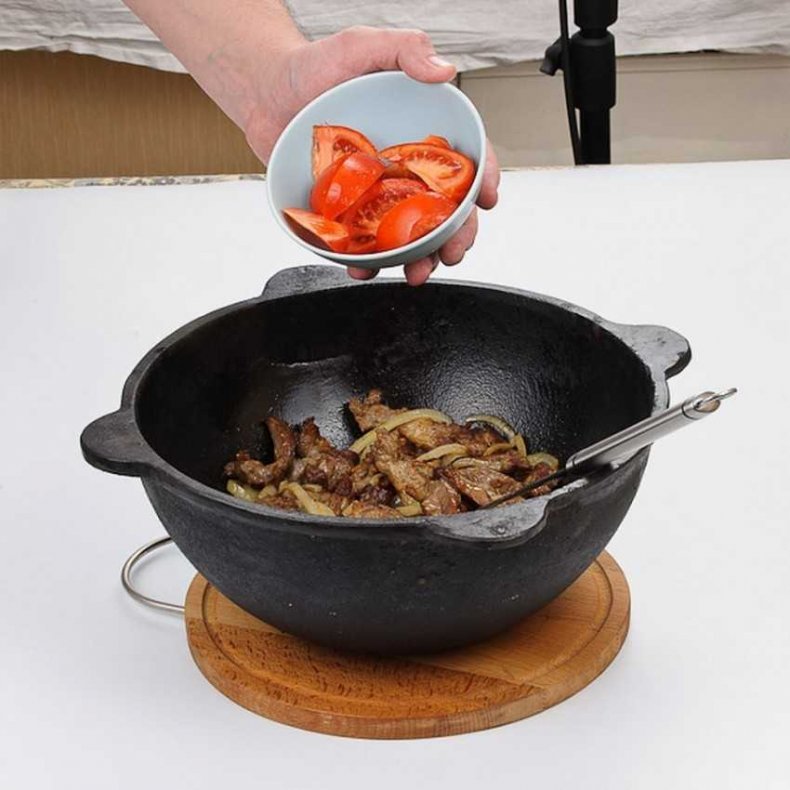
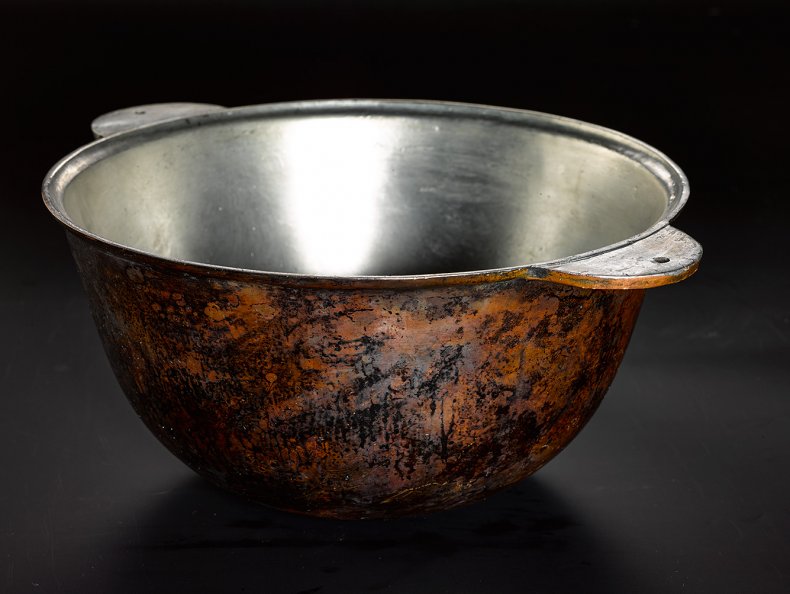
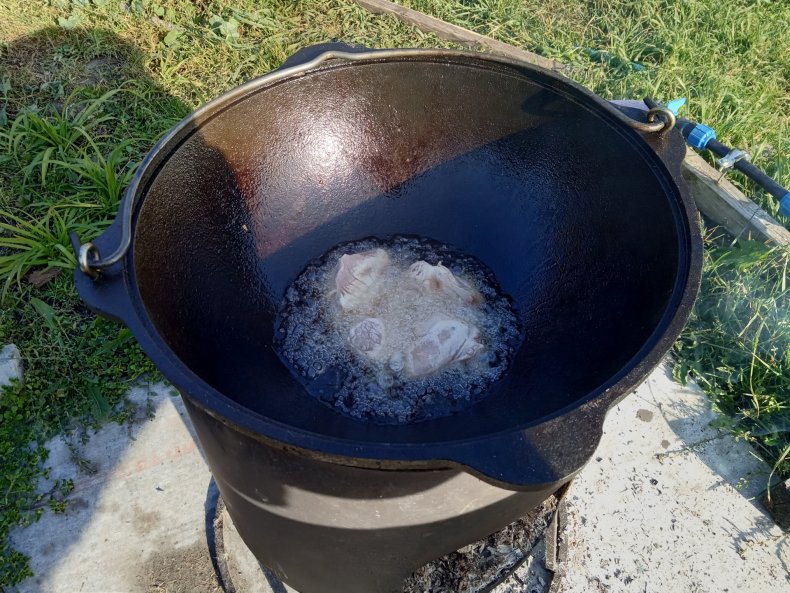
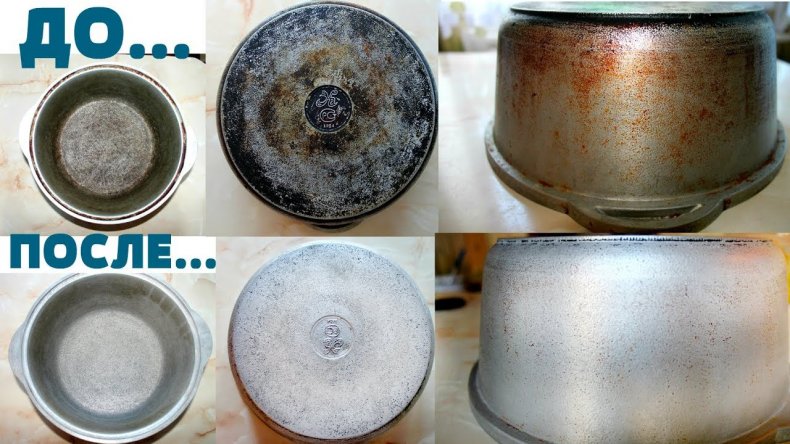
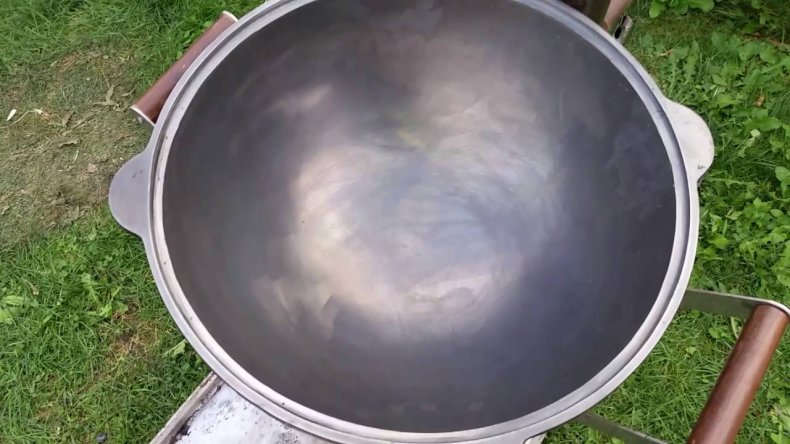
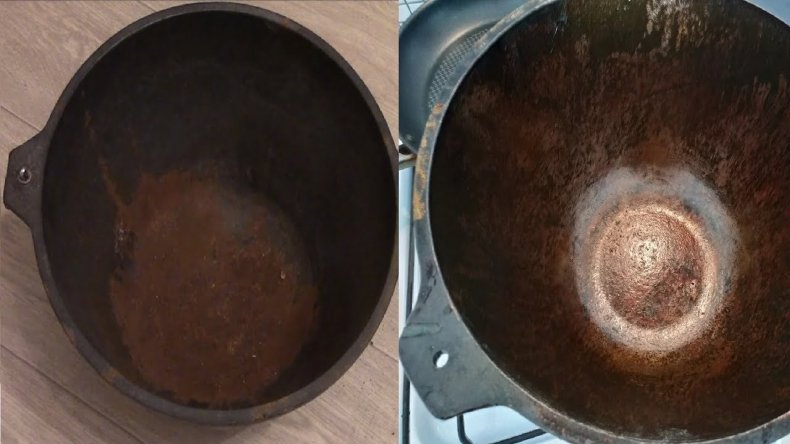
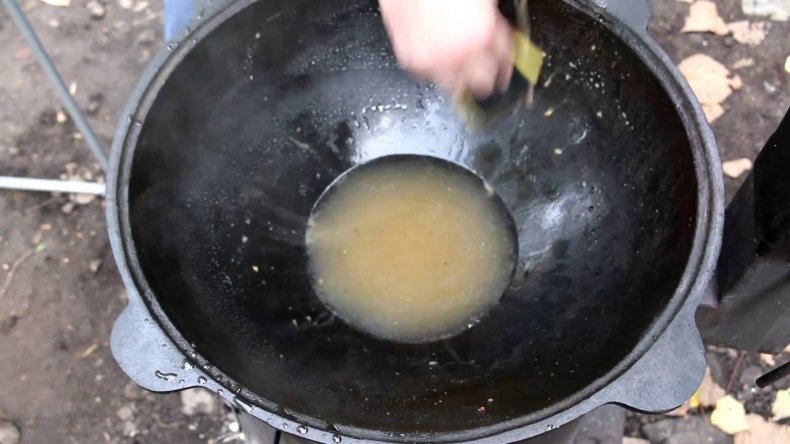
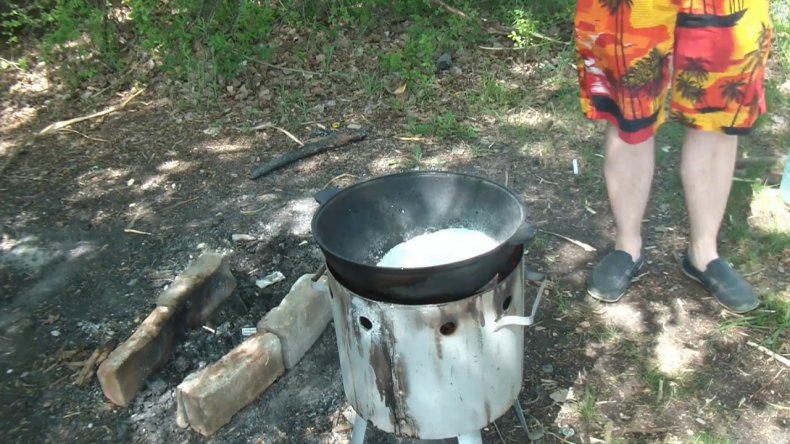
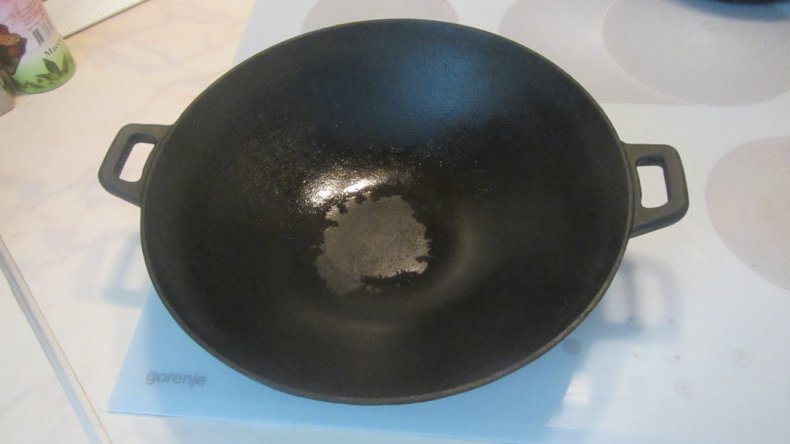
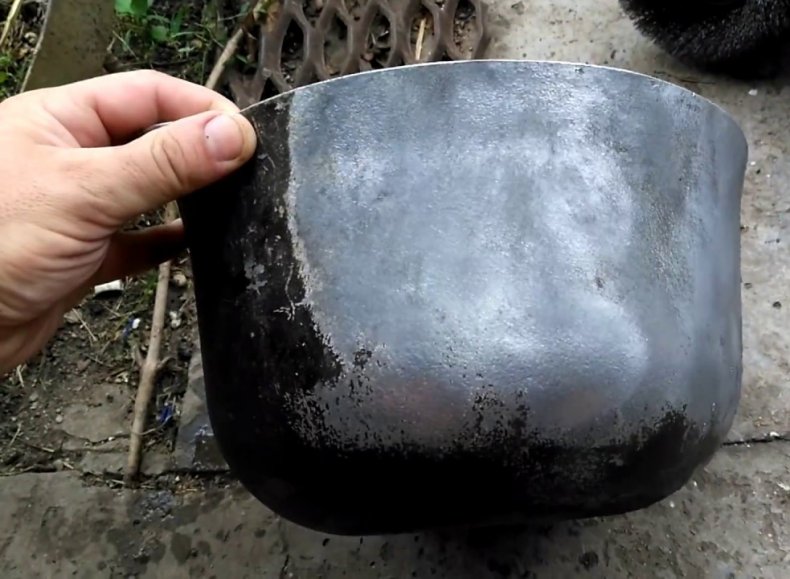
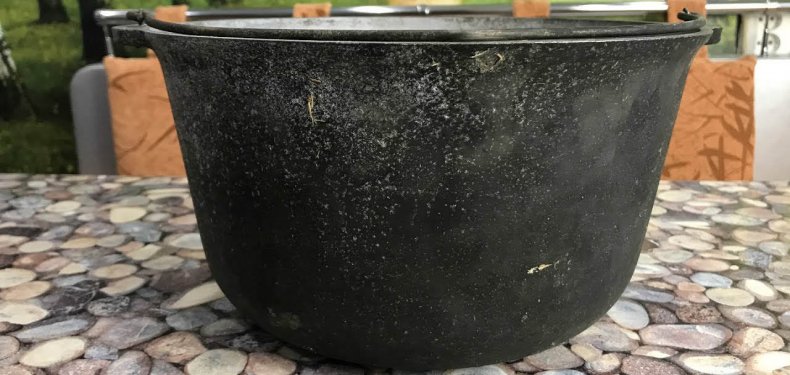
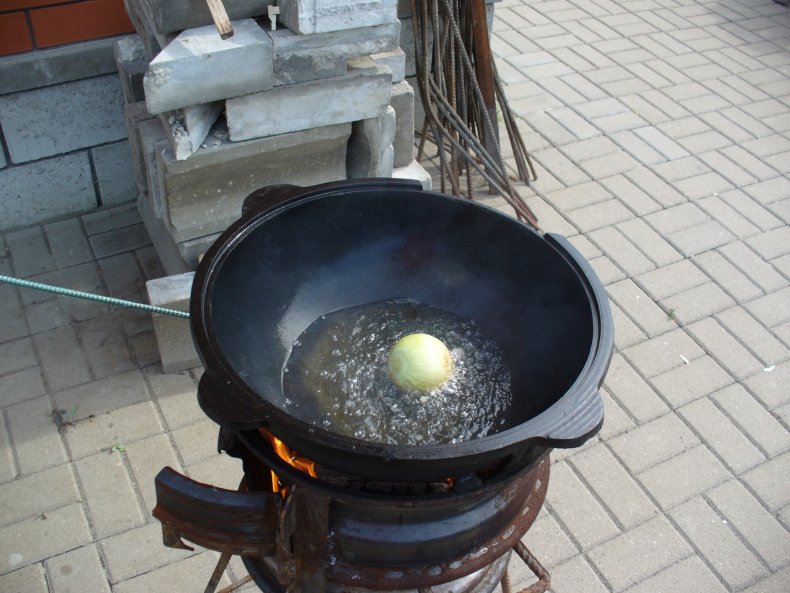
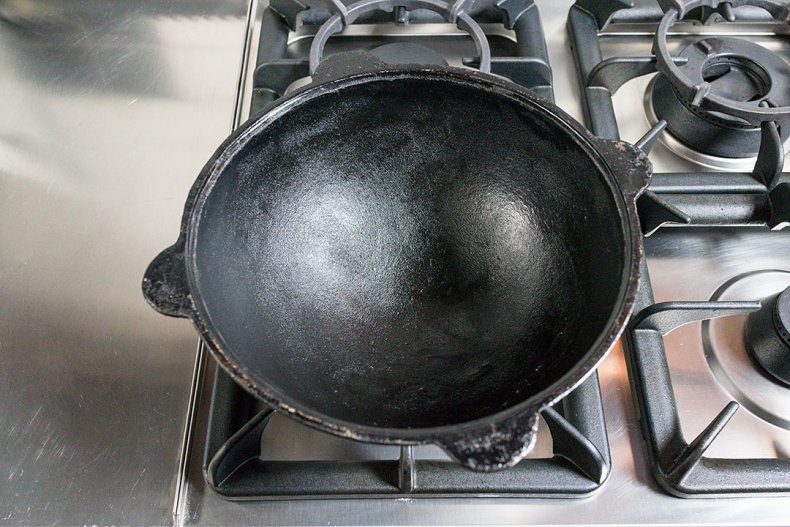

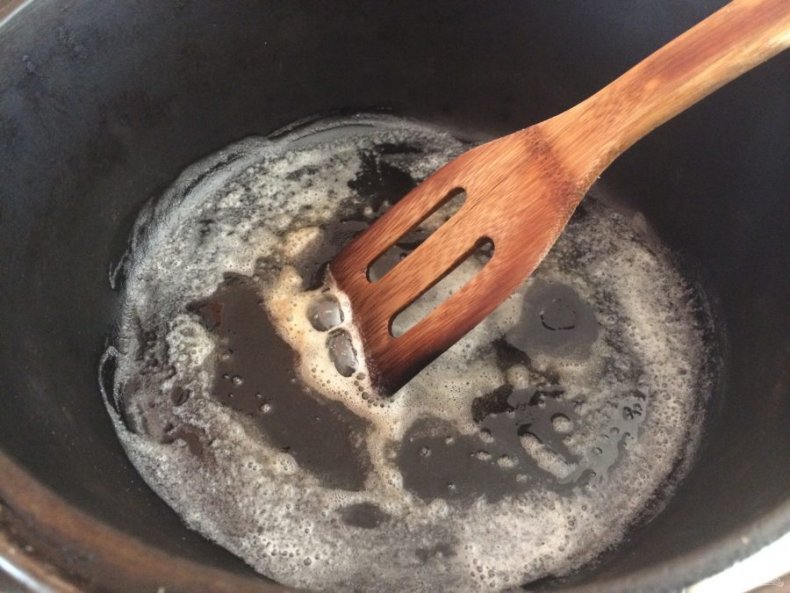

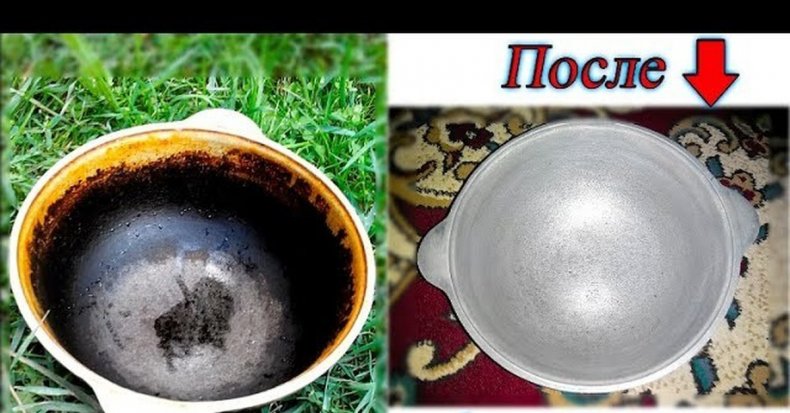
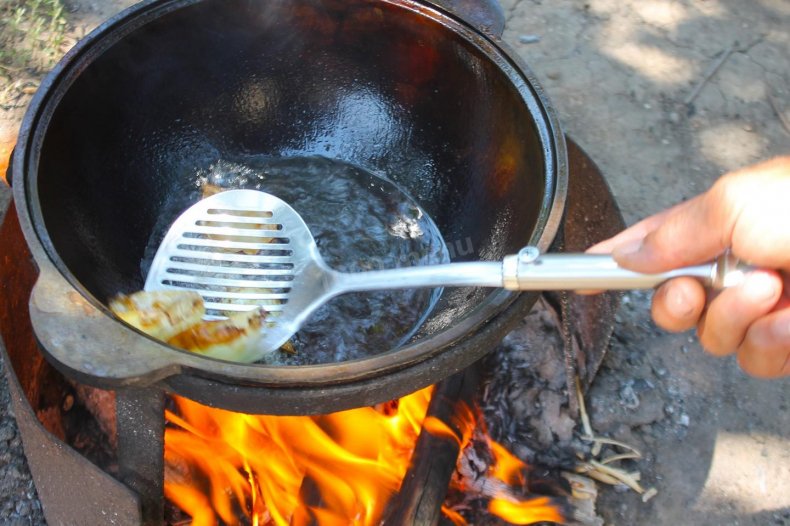
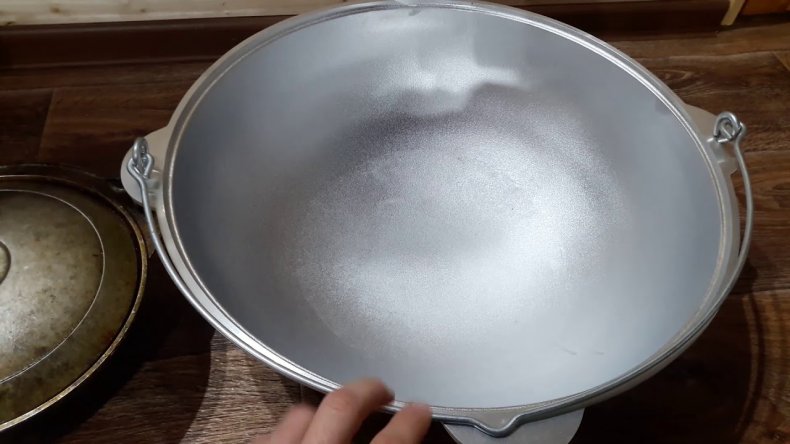
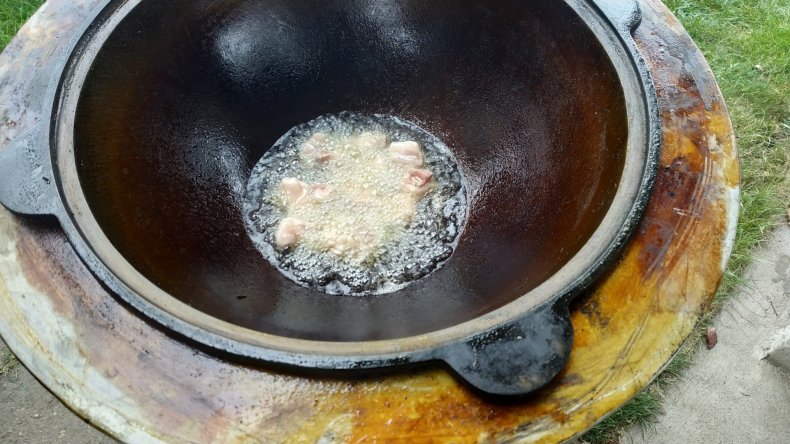
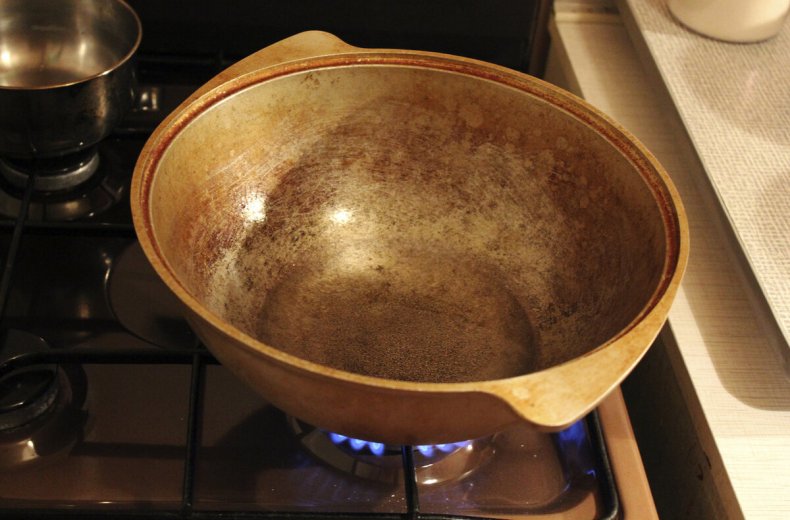
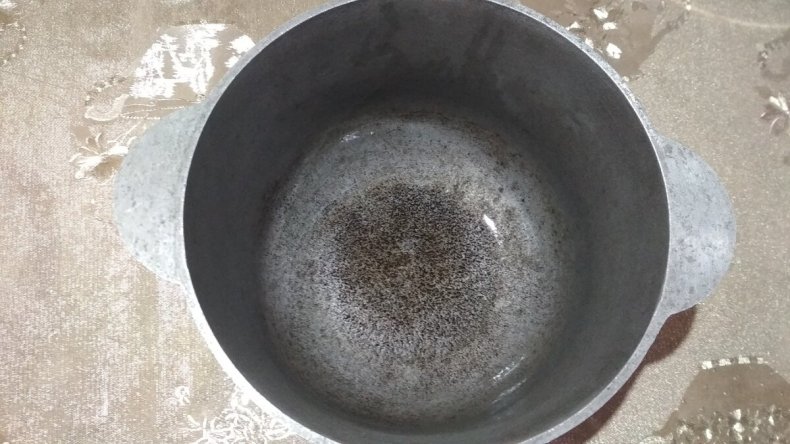
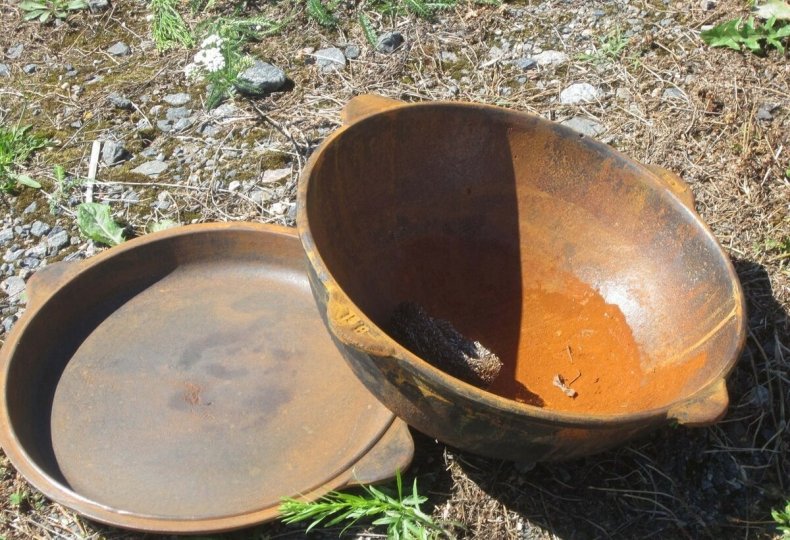
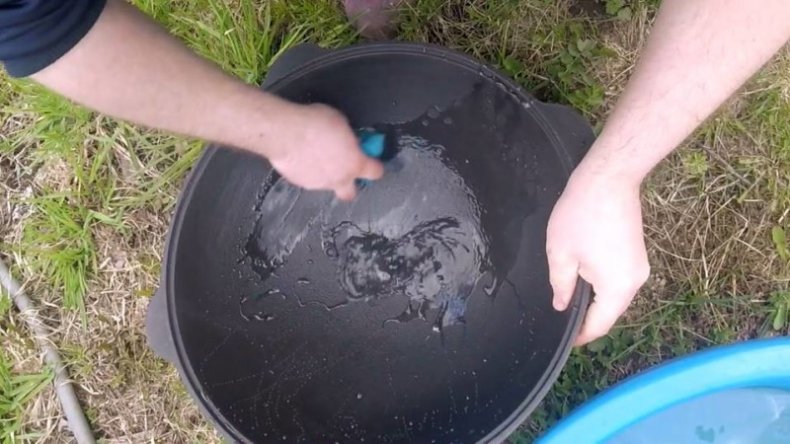
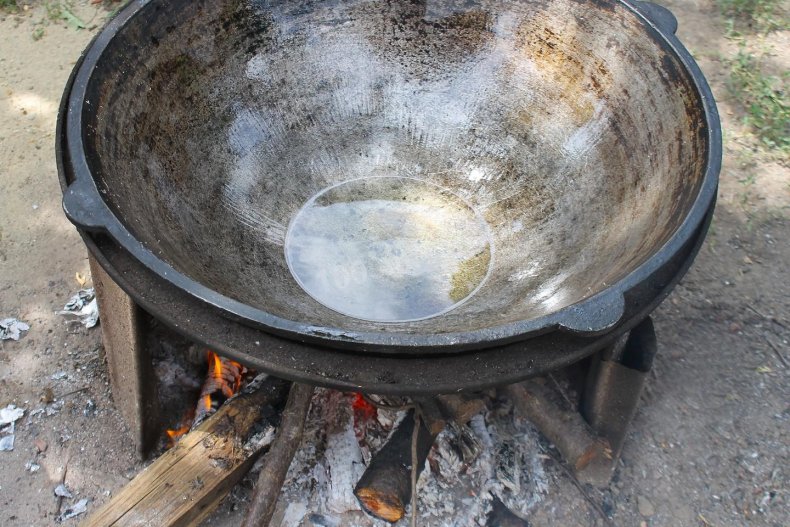
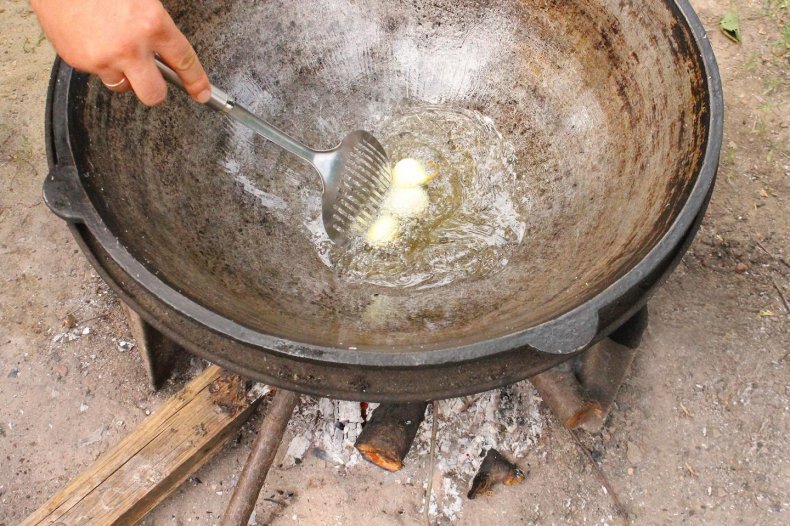
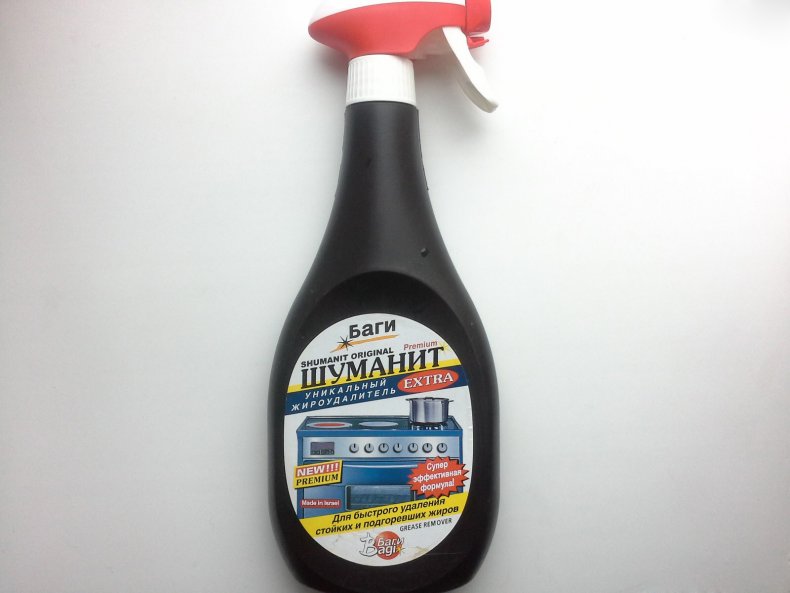
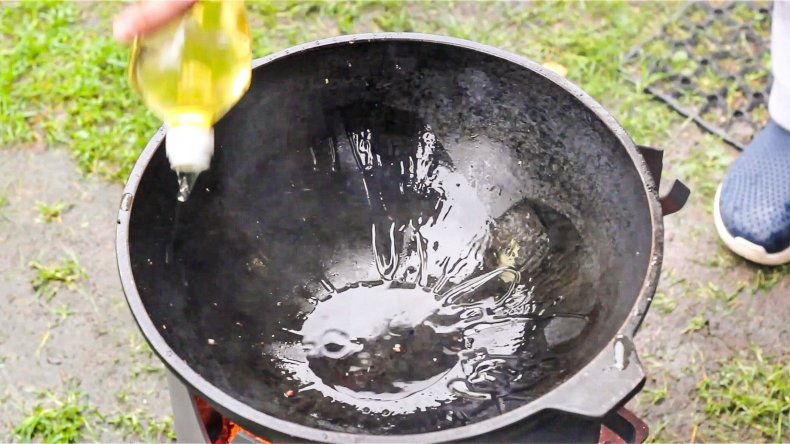

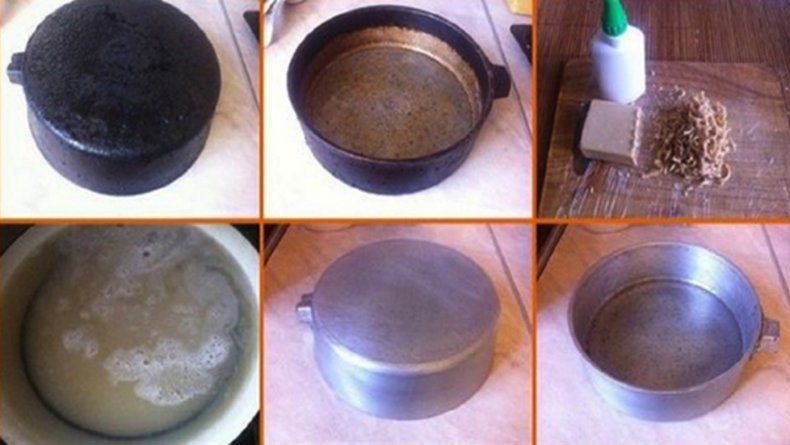
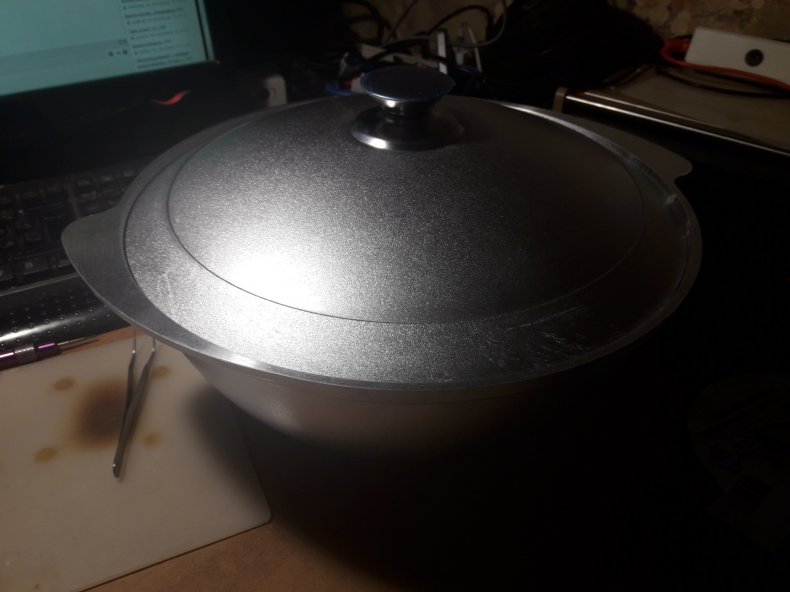
Why does cast iron rust?
If we talk about a cast iron cauldron, moisture is the cause of rust. Even if you properly care for the dishes, with an increased level of humidity in an apartment or house, everything will be evenly rusted.These are natural reasons why cast iron cookware rusts, and in order to get rid of corrosion once and for all, you need to know how to properly handle it.
Rust cleaning tips
Improper storage leads to the appearance of a red coating - rust. To remove it, the dishes are pre-soaked in a solution of water and vinegar in equal proportions. You can add special chemicals that corrode rust. The following improvised means are suitable for cleaning plaque:
- medium-grained and coarse-grained sandpaper, metal shavings (help with slight contamination);
- a drill with a flat nozzle (after using the tool, it is necessary to remove corrosion from the metal pores with phosphoric or oxalic acid);
- grinder (removes the rusty layer in a few minutes, the procedure must be performed by a person with professional skills).
 Requires bluing - oil firing, creates anti-corrosion protection and non-stick layer.
Requires bluing - oil firing, creates anti-corrosion protection and non-stick layer.
Digestion copes with a large layer of unpleasant plaque. To do this, add one pack of salt to a bucket with 6 liters of water. Place a cauldron and cook for 8 hours over low heat.
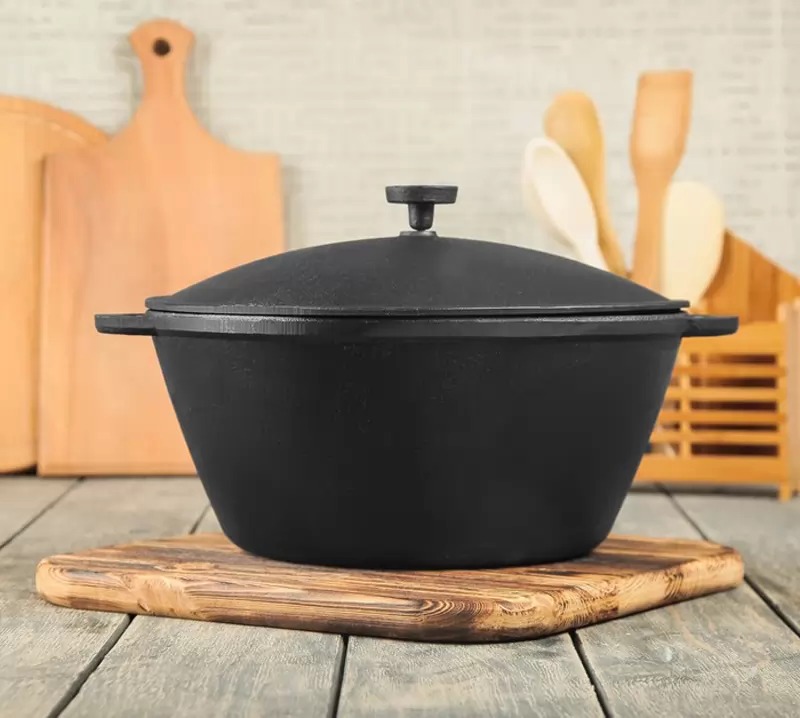 Cast iron does not like scratching, this destroys the oily layer, opens micropores, and food particles clog in them.
Cast iron does not like scratching, this destroys the oily layer, opens micropores, and food particles clog in them.
You can remove rust from a cauldron using a special tool designed to care for the oven. You can also use a folk remedy. The minimum plaque is removed with peeled potatoes, then washed off with warm water and dried well.
 Peeled potatoes will help remove plaque from the cauldron.
Peeled potatoes will help remove plaque from the cauldron.
How to protect a cast iron cauldron from rusting
In order for cast iron not to rust, there should always be a small layer of fat on its walls.In this case, even in conditions of high humidity, the metal will not be subject to corrosion.
How to properly wash and clean the pot:
- a cast-iron cauldron is best washed without the use of hard washcloths, as well as any substances containing abrasives;
- it should be understood that the cast-iron cauldron must be washed after each use, otherwise soot will form;
- cast iron kitchen utensils should only be washed after they have completely cooled down;
The first use deserves special attention. When it comes to a cast iron cauldron, you can’t just bring it from the store and cook it right away. In this case, the dishes must be prepared, namely, burned with salt. The fact is that in the manufacturing process, manufacturers use engine oil, which protects the product from corrosion. For long-term and safe use, roasting is used, which will prepare the metal and also remove all traces of oil.
How to restore the non-stick layer after cleaning
Often, along with soot, the protective layer is removed. Boilers made of ferrous metal only need this procedure. There are several ways to return oily protection, but the simplest of them is calcination.
What needs to be done:
- flush the boiler;
- dry completely;
- apply fat of animal origin to the walls;
- put on a strong fire for 5 minutes (until the fat burns out);
- cool and rinse with water.
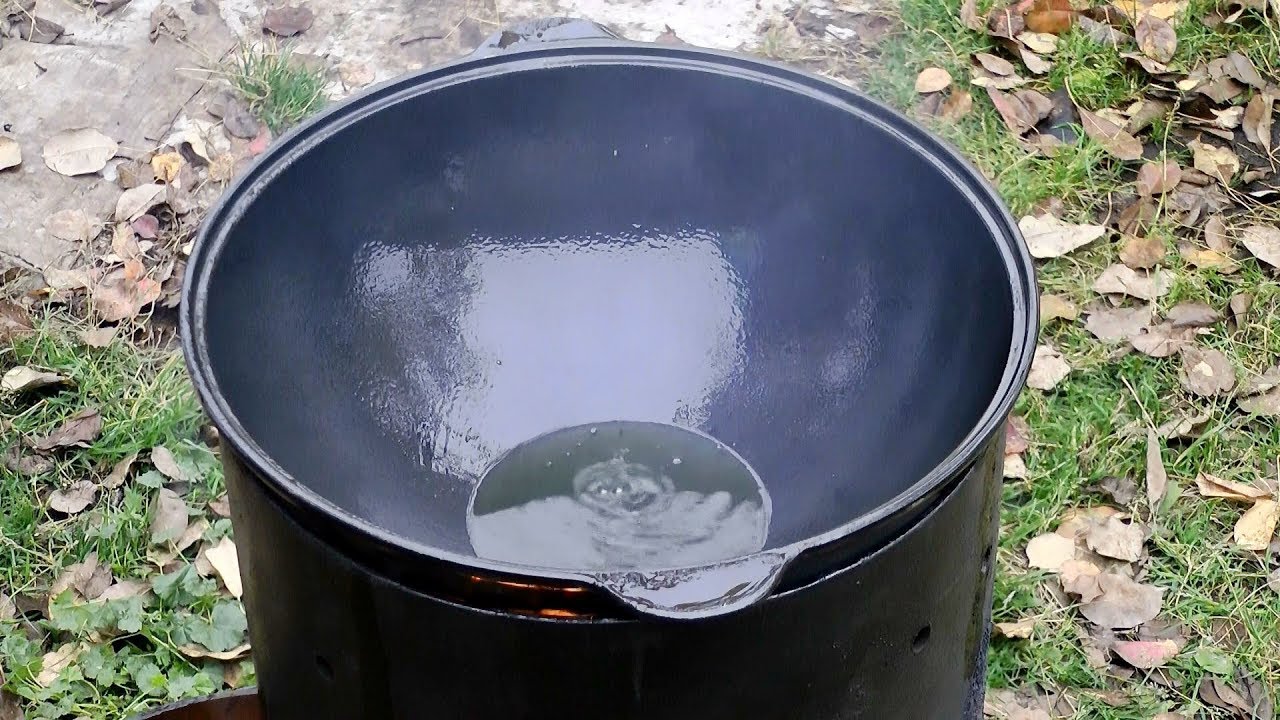 From oil hardening, cast iron becomes shiny, shiny.
From oil hardening, cast iron becomes shiny, shiny.
A cauldron made of cast iron is hardened on a fire with the addition of oil. After its complete burnout, the boiler is filled with water and boiled.
Knowing how to effectively clean a metal cauldron after cooking will help maintain its performance for a long time. A properly prepared kettle does not need special washing.
Before washing the cauldron, we free it from the remnants of food. Pour water into the dishes, put on fire to boil and leave to cool. After that, the container is freed from the liquid, washed with liquid detergent and the soft side of the sponge.
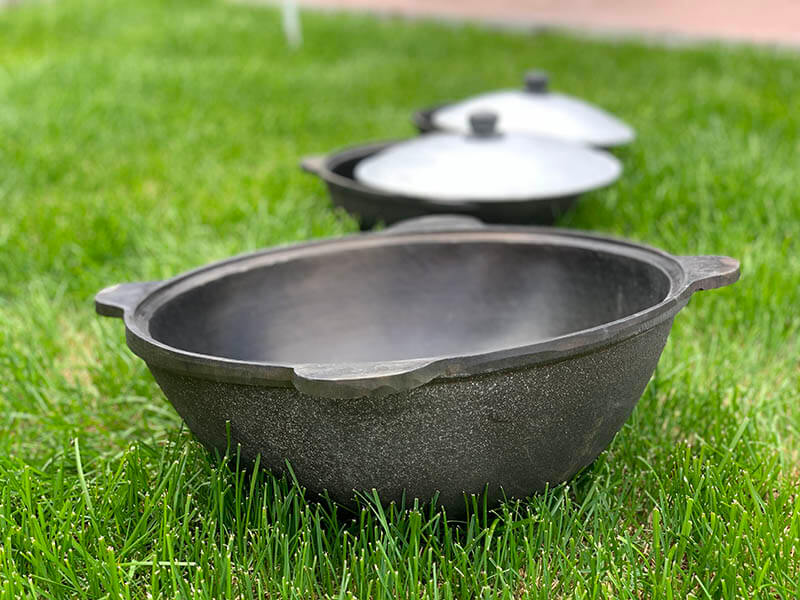 In a processed cauldron, food will never burn, it will be tasty, healthy.
In a processed cauldron, food will never burn, it will be tasty, healthy.
We wipe the inside and outside of the dish dry, apply a small amount of oil on the walls and put it in the cupboard for storage with the lid open.
Useful tips for the care and prevention of soot
How to wash a cauldron? The most important thing that every housewife should remember is that the boiler must be wiped dry after washing. If the dishes are left damp, rust spots cannot be avoided.
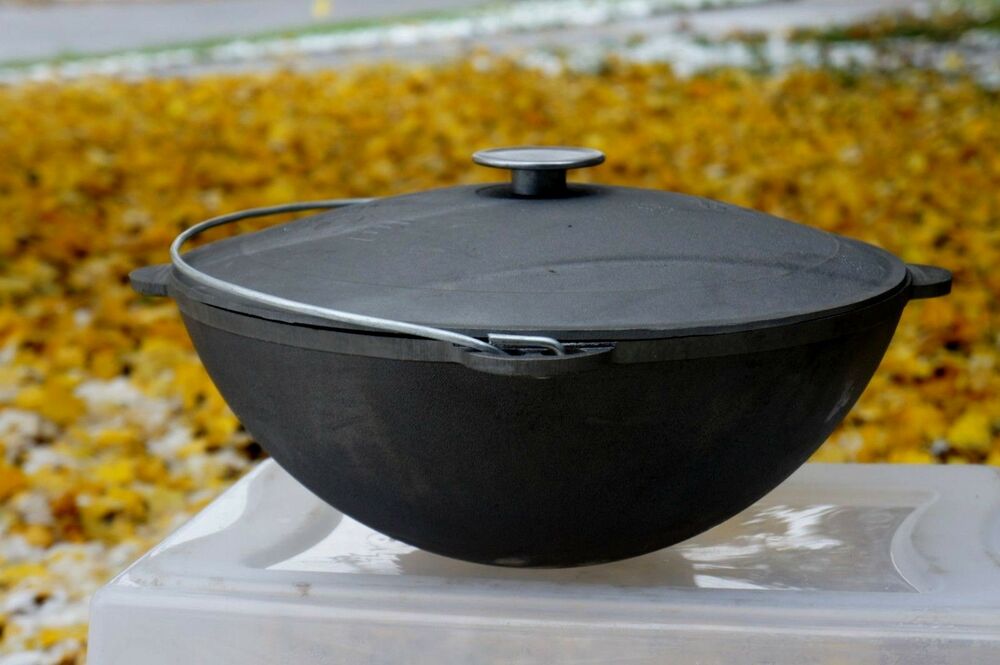 With the constant use of dishes, calcination is carried out at least twice a year.
With the constant use of dishes, calcination is carried out at least twice a year.
Frequent use of the product involves applying a layer of oil to the inner walls of the cauldron. So the food will not burn.
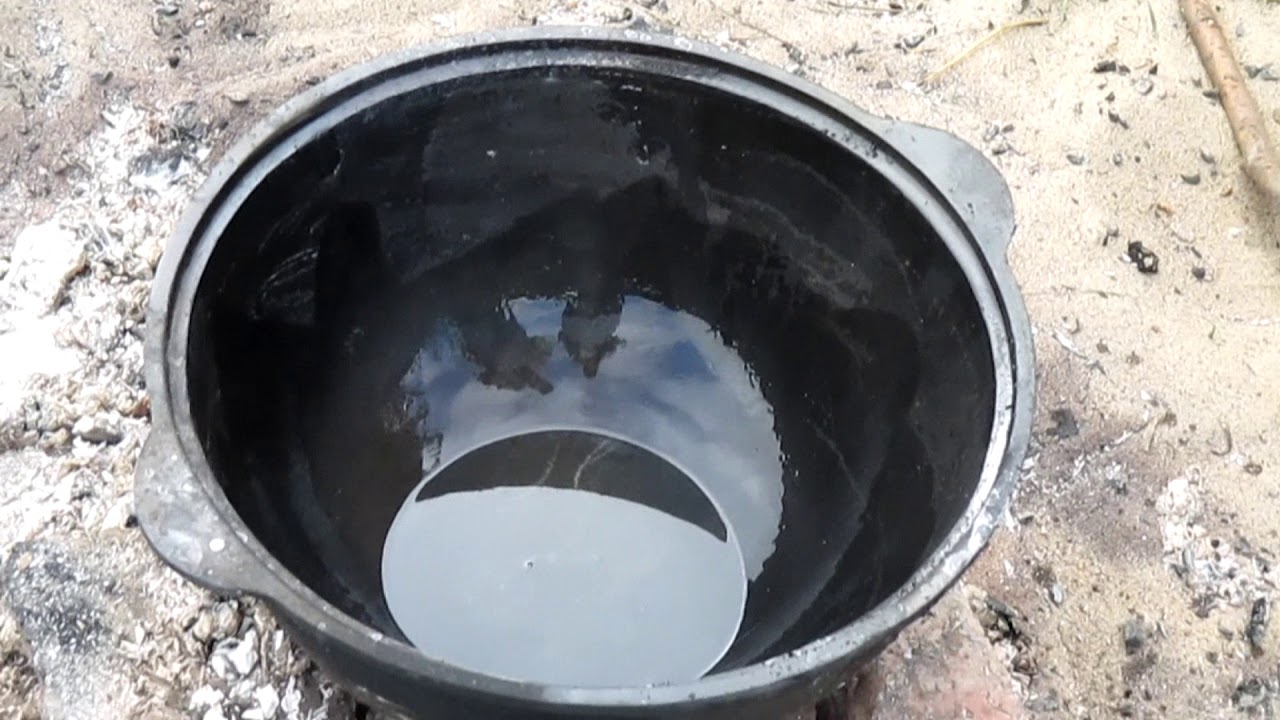
The service life of thick-walled metal utensils is not limited.
Air should flow freely to the place where the dishes are stored. The cauldron must not be tightly covered with a lid if its inner surface is covered with oil. The storage cabinet must be dry.
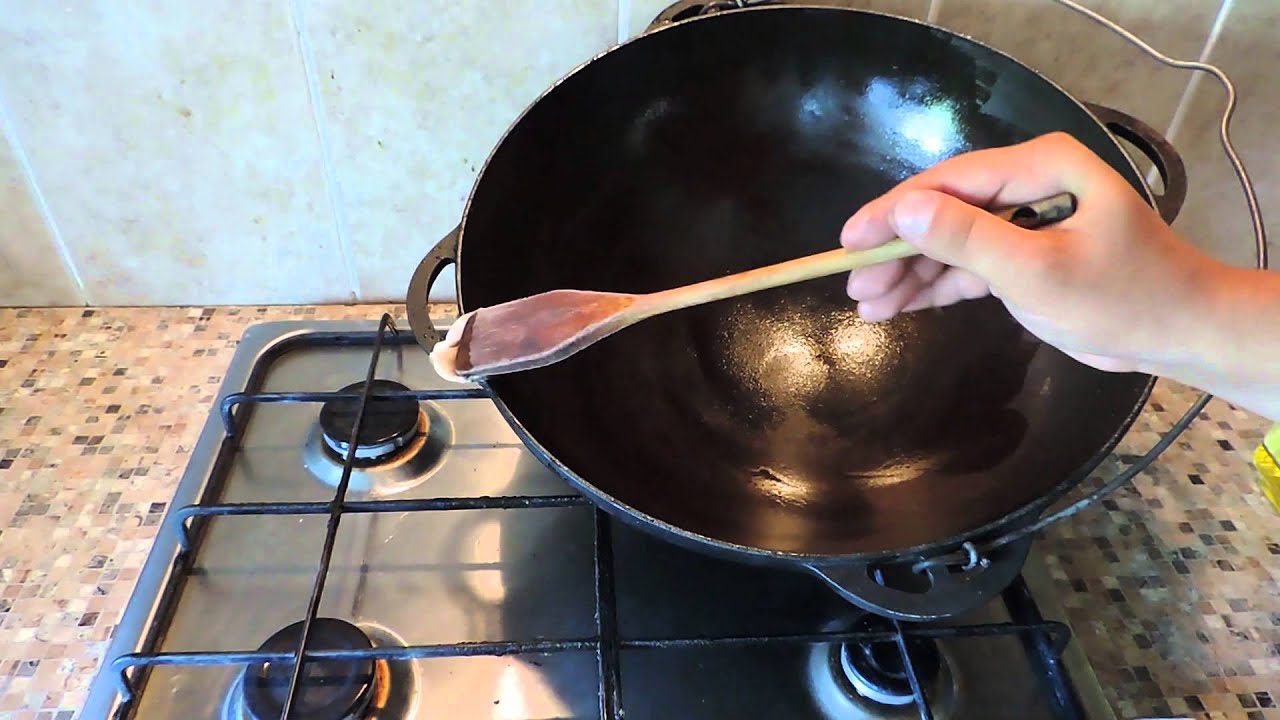 Store cast iron in oiled cloth or paper.
Store cast iron in oiled cloth or paper.
Before the first use, the product requires piercing in a preheated oven. At the same time, the oven does not warm up in advance, the temperature increase should occur gradually (at least 200 ° C).After cooking, the cauldron is immediately washed from food debris; it cannot be soaked for a long time.
 After cleaning, be sure to wash the cauldron with warm water using detergents.
After cleaning, be sure to wash the cauldron with warm water using detergents.
Why polishing is needed and how to carry it out
Nothing is perfect in this world. When pouring cast iron molds, there are errors in the form of sagging, flaws, roughness.In this case, the cauldron must first be peeled off with a thick grinder circle. Then you need to change the circle to a large stone, and then grind it with a petal fine emery wheel. This takes about an hour. After this procedure, it is necessary to carry out firing.
Proper storage is the key to a long service life of a cast-iron cauldron
Metal such as cast iron itself is prone to corrosion. According to experts, as well as ordinary users, this is the only drawback of this cookware. However, if you know exactly how to use a cast iron cauldron, it will last for many years without any problems.
How to store a cast iron cauldron:
- After washing, the surface of the product must be wiped dry each time. Even a small drop of water can rust this metal, so care must be taken to ensure that moisture is completely removed.
- The cauldron should only be kept in a dry place with good ventilation. The place under the sink, where many people store dishes, is not suitable. The ideal option would be a separate pantry or locker.
- In order to prevent the appearance of rust, it is better to wipe its surface with a thin layer of vegetable oil every time after using the cauldron.
- If you have several cauldrons at once, in no case should you store them by folding them into each other.Such actions can lead to the appearance of an unpleasant odor, since in this case the dishes will be deprived of access to oxygen.
